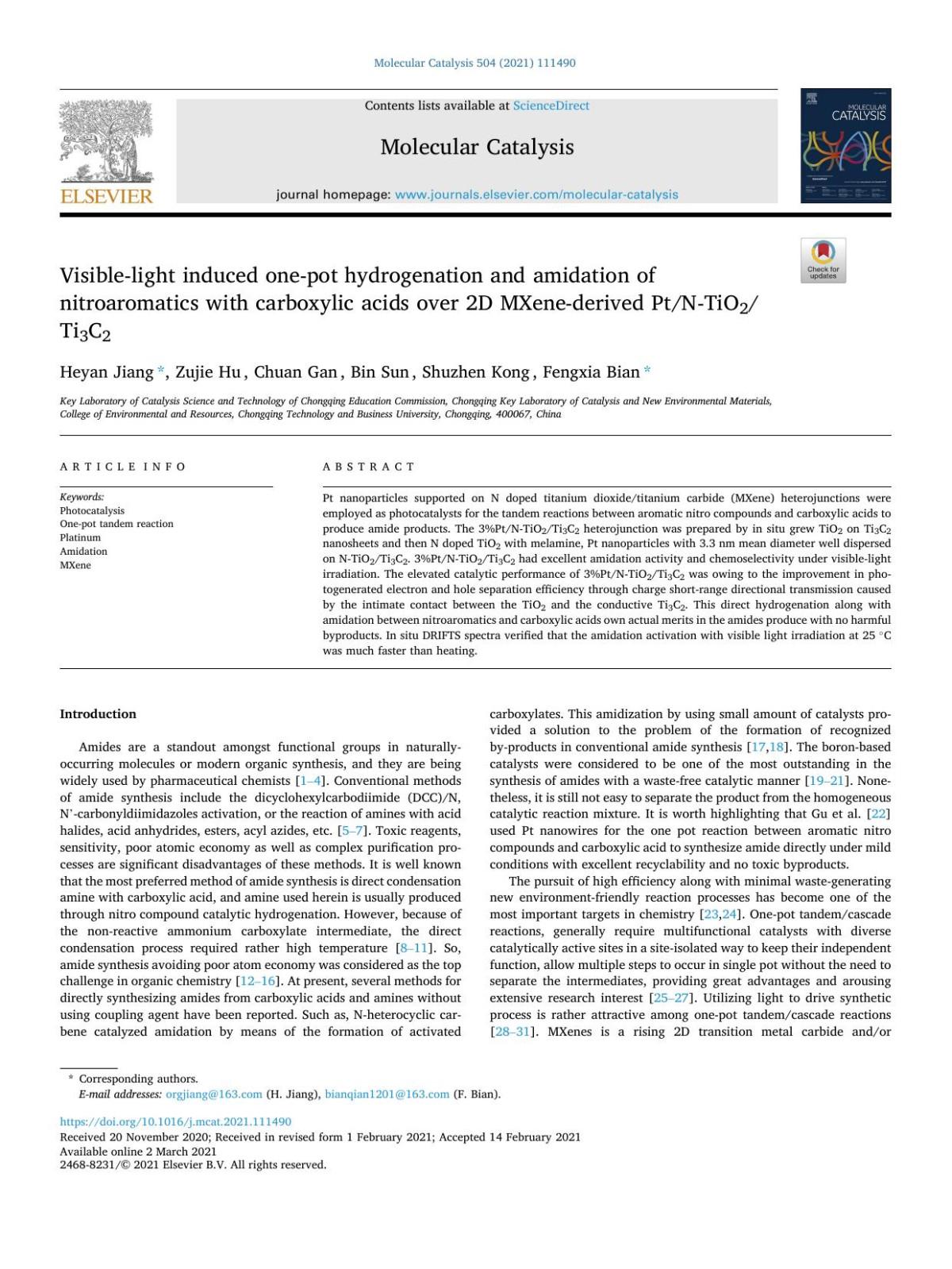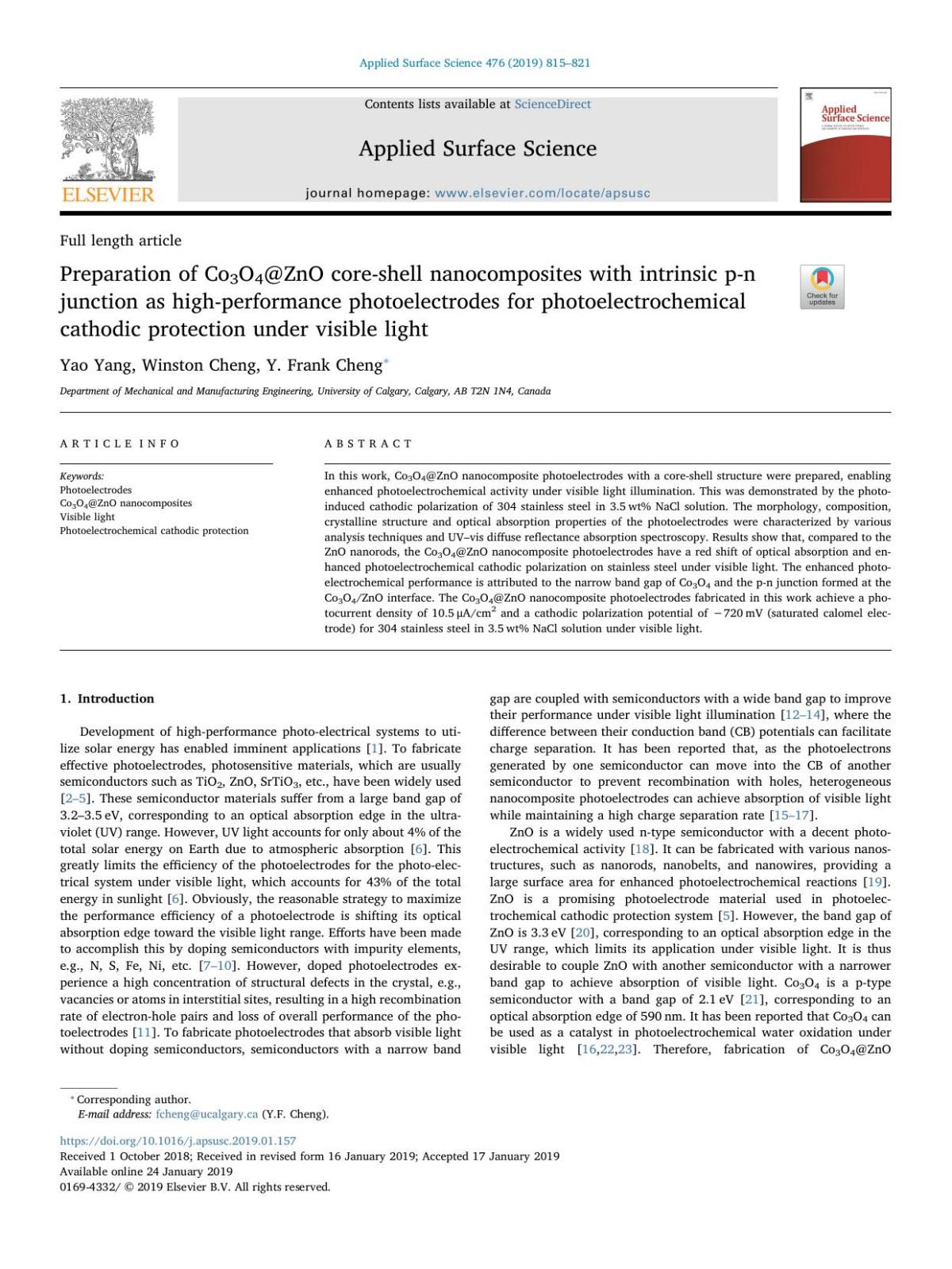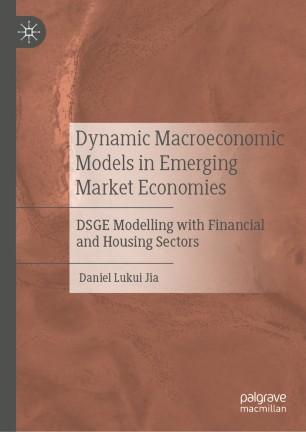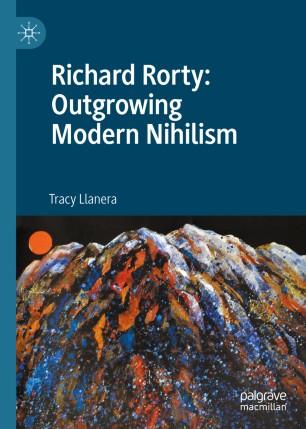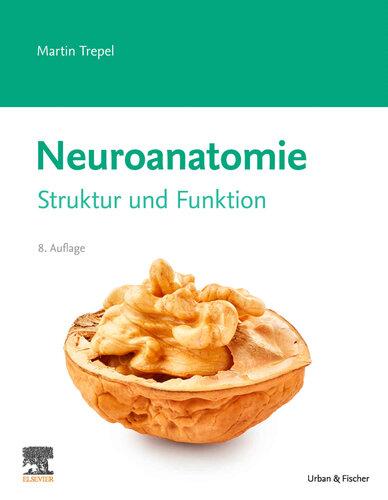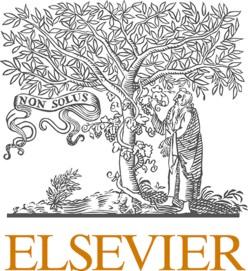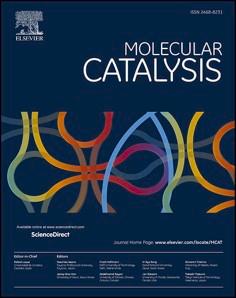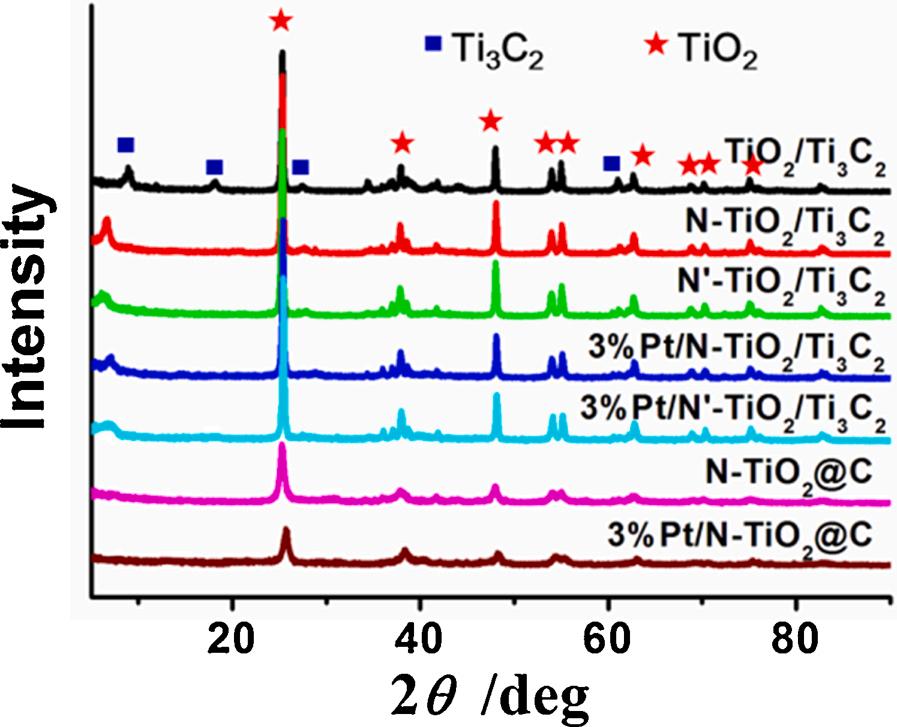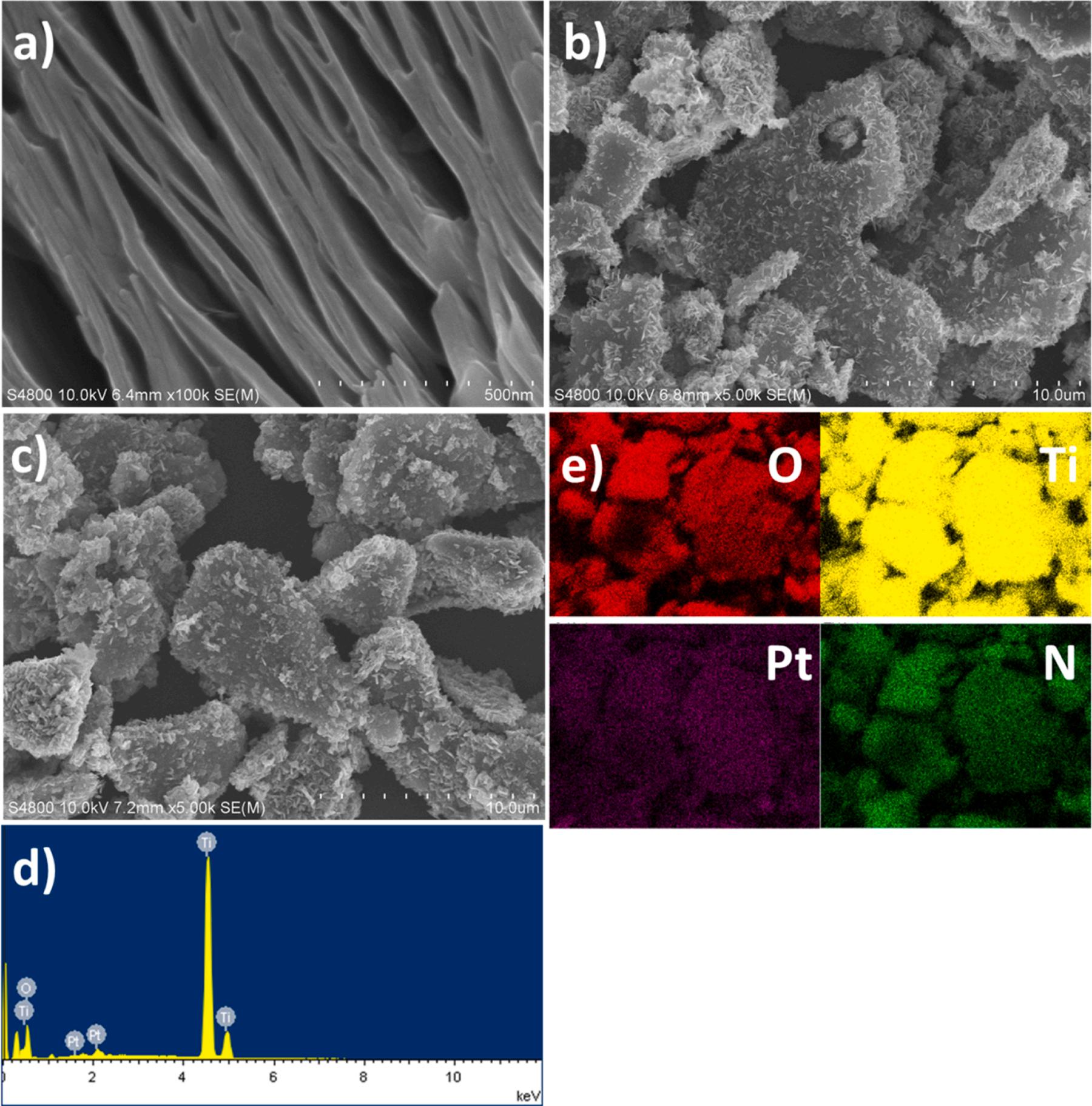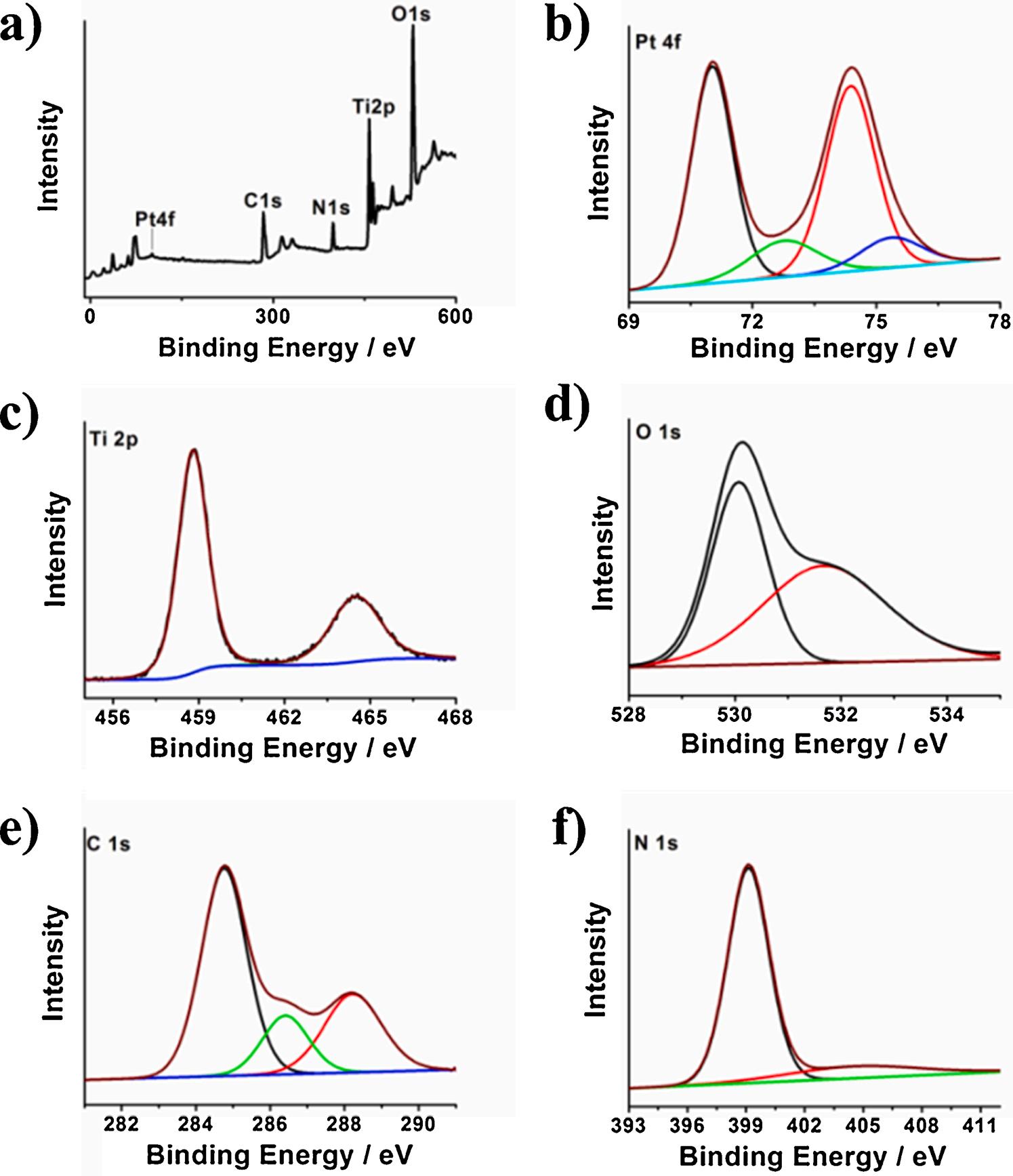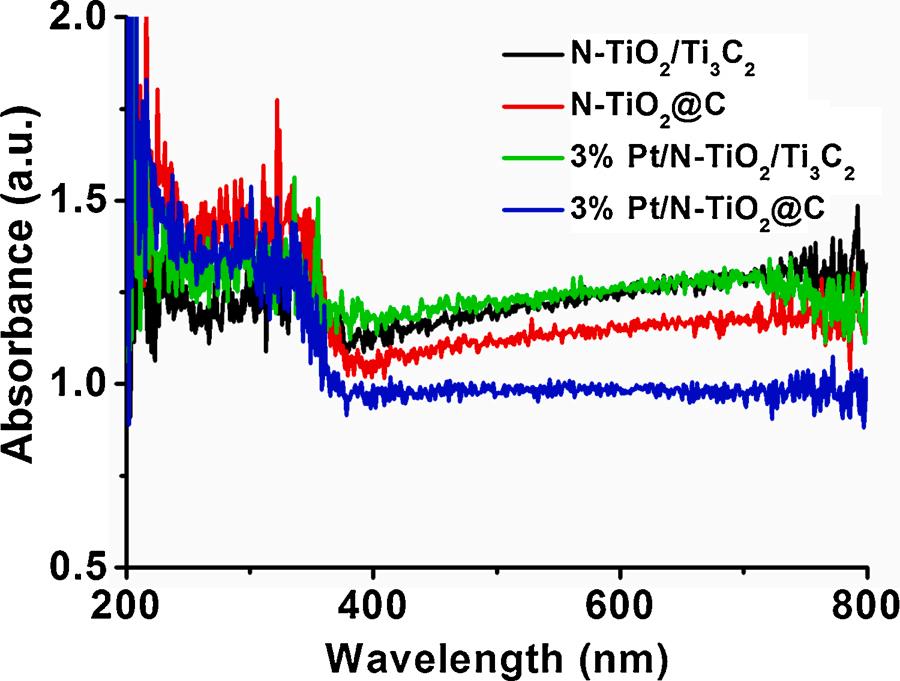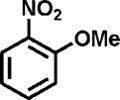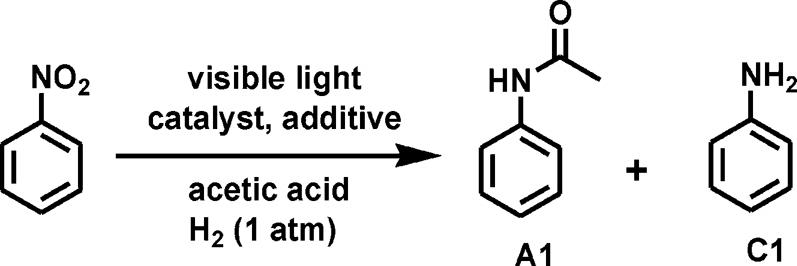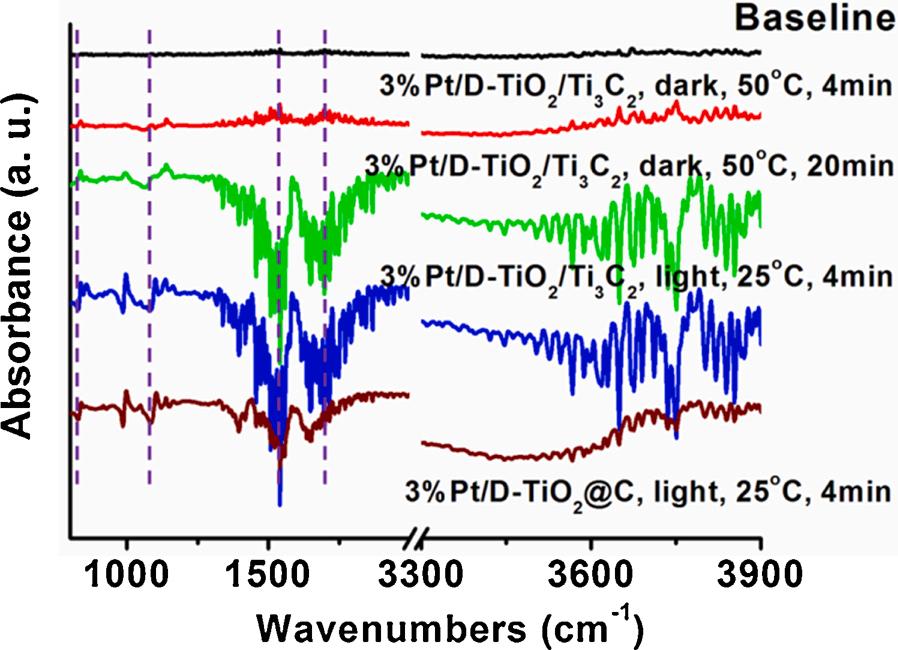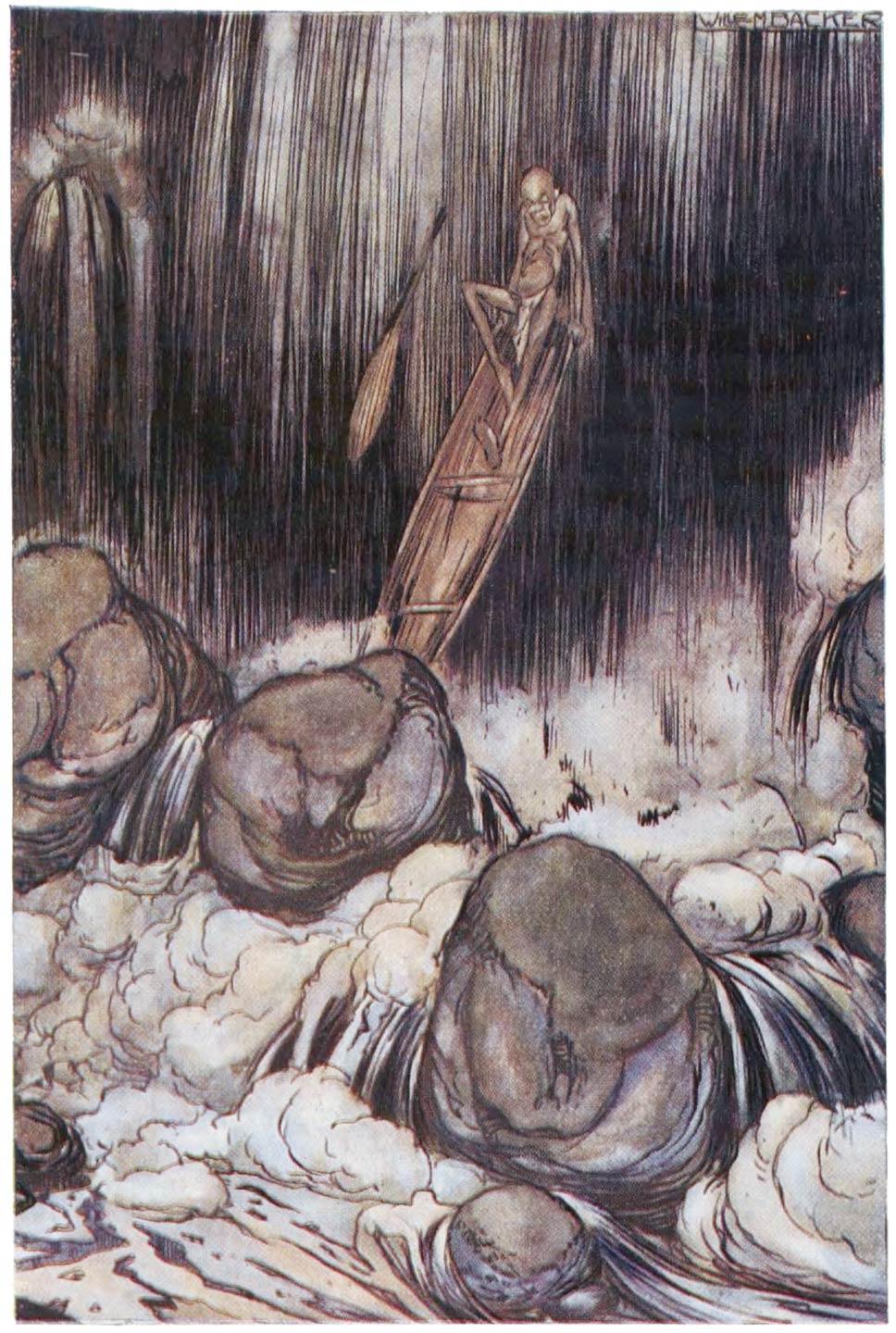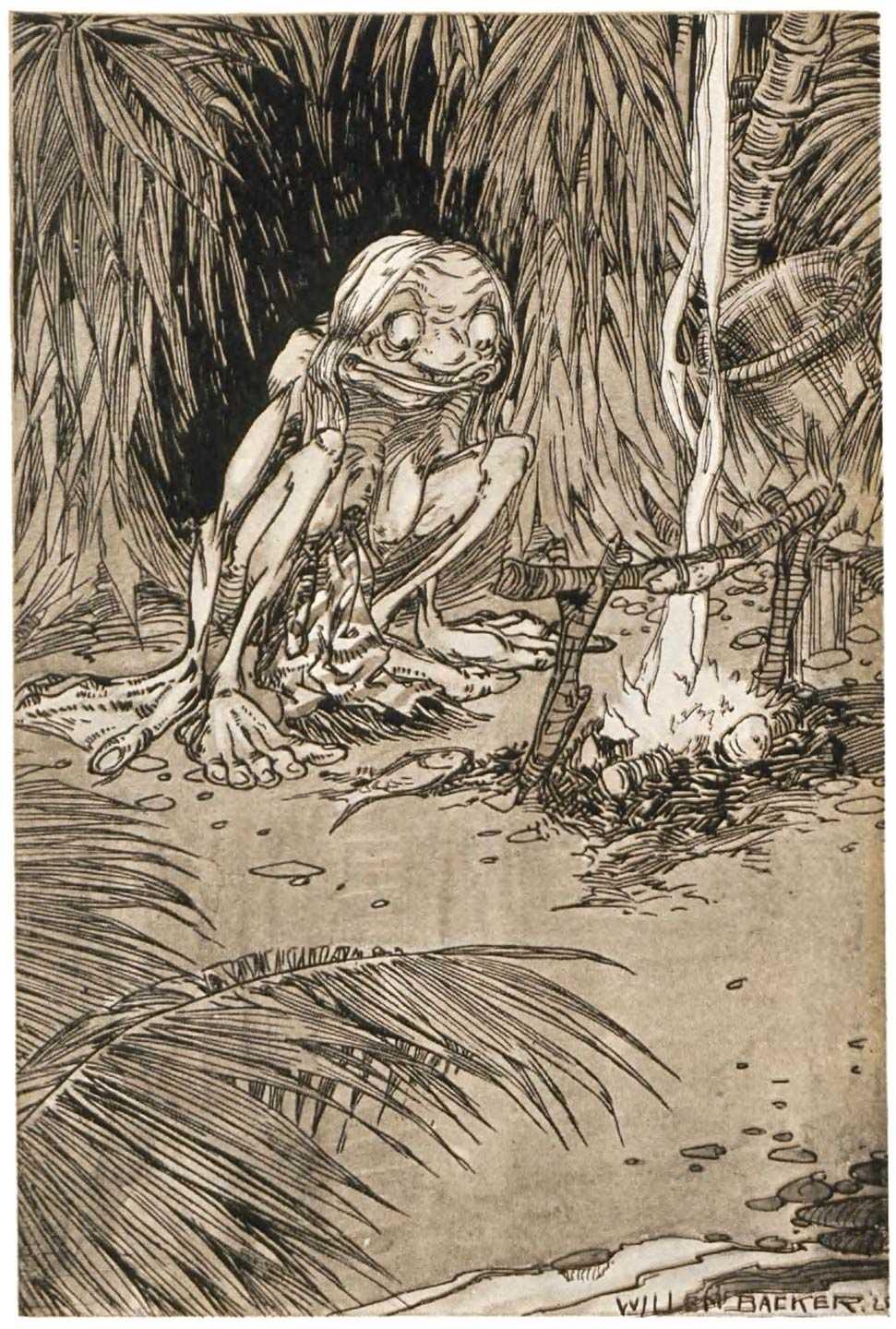Molecular Catalysis
journal homepage: www.journals.elsevier.com/molecular-catalysis
Visible-light induced one-pot hydrogenation and amidation of nitroaromatics with carboxylic acids over 2D MXene-derived Pt/N-TiO2/ Ti3C2
Heyan Jiang * , Zujie Hu , Chuan Gan , Bin Sun , Shuzhen Kong , Fengxia Bian *
Key Laboratory of Catalysis Science and Technology of Chongqing Education Commission, Chongqing Key Laboratory of Catalysis and New Environmental Materials, College of Environmental and Resources, Chongqing Technology and Business University, Chongqing, 400067, China
ARTICLE INFO
Keywords:
Photocatalysis
One-pot tandem reaction
Platinum
Amidation
MXene
ABSTRACT
Pt nanoparticles supported on N doped titanium dioxide/titanium carbide (MXene) heterojunctions were employed as photocatalysts for the tandem reactions between aromatic nitro compounds and carboxylic acids to produce amide products. The 3%Pt/N-TiO2/Ti3C2 heterojunction was prepared by in situ grew TiO2 on Ti3C2 nanosheets and then N doped TiO2 with melamine, Pt nanoparticles with 3.3 nm mean diameter well dispersed on N-TiO2/Ti3C2. 3%Pt/N-TiO2/Ti3C2 had excellent amidation activity and chemoselectivity under visible-light irradiation. The elevated catalytic performance of 3%Pt/N-TiO2/Ti3C2 was owing to the improvement in photogenerated electron and hole separation efficiency through charge short-range directional transmission caused by the intimate contact between the TiO2 and the conductive Ti3C2 This direct hydrogenation along with amidation between nitroaromatics and carboxylic acids own actual merits in the amides produce with no harmful byproducts. In situ DRIFTS spectra verified that the amidation activation with visible light irradiation at 25
was much faster than heating.
Introduction
Amides are a standout amongst functional groups in naturallyoccurring molecules or modern organic synthesis, and they are being widely used by pharmaceutical chemists [1–4]. Conventional methods of amide synthesis include the dicyclohexylcarbodiimide (DCC)/N, N’-carbonyldiimidazoles activation, or the reaction of amines with acid halides, acid anhydrides, esters, acyl azides, etc. [5–7]. Toxic reagents, sensitivity, poor atomic economy as well as complex purification processes are significant disadvantages of these methods. It is well known that the most preferred method of amide synthesis is direct condensation amine with carboxylic acid, and amine used herein is usually produced through nitro compound catalytic hydrogenation. However, because of the non-reactive ammonium carboxylate intermediate, the direct condensation process required rather high temperature [8–11]. So, amide synthesis avoiding poor atom economy was considered as the top challenge in organic chemistry [12–16]. At present, several methods for directly synthesizing amides from carboxylic acids and amines without using coupling agent have been reported. Such as, N-heterocyclic carbene catalyzed amidation by means of the formation of activated
* Corresponding authors.
carboxylates. This amidization by using small amount of catalysts provided a solution to the problem of the formation of recognized by-products in conventional amide synthesis [17,18]. The boron-based catalysts were considered to be one of the most outstanding in the synthesis of amides with a waste-free catalytic manner [19–21]. Nonetheless, it is still not easy to separate the product from the homogeneous catalytic reaction mixture. It is worth highlighting that Gu et al. [22] used Pt nanowires for the one pot reaction between aromatic nitro compounds and carboxylic acid to synthesize amide directly under mild conditions with excellent recyclability and no toxic byproducts.
The pursuit of high efficiency along with minimal waste-generating new environment-friendly reaction processes has become one of the most important targets in chemistry [23,24]. One-pot tandem/cascade reactions, generally require multifunctional catalysts with diverse catalytically active sites in a site-isolated way to keep their independent function, allow multiple steps to occur in single pot without the need to separate the intermediates, providing great advantages and arousing extensive research interest [25–27]. Utilizing light to drive synthetic process is rather attractive among one-pot tandem/cascade reactions [28–31]. MXenes is a rising 2D transition metal carbide and/or
E-mail addresses: orgjiang@163.com (H. Jiang), bianqian1201@163.com (F. Bian).
https://doi.org/10.1016/j.mcat.2021.111490
Received 20 November 2020; Received in revised form 1 February 2021; Accepted 14 February 2021
Availableonline2March2021 2468-8231/©2021ElsevierB.V.Allrightsreserved.
Fig. 1. XRD patterns of TiO2/Ti3C2, N-TiO2/Ti3C2, N’-TiO2/Ti3C2, 3%Pt/NTiO2/Ti3C2, 3%Pt/N’-TiO2/Ti3C2, N-TiO2@C and 3%Pt/N-TiO2@C.
carbonitride with a general formula Mn+1XnTx (n = 1, 2, 3; Tx = OH, O, F group) [32,33]. Owing to the excellent structure and chemical properties, MXenes have been extensively studied during the past few years [34–39]. MXene has excellent electron conductivity which makes it easier to transfer charge from the semiconductor to MXene and improves the separation efficiency of electron and hole thus achieving directional charge transmission [40,41]. With above unique nature, MXene is viewed as one of the most promising photocatalytic material.
Herein, we report Pt nanoparticles supported on N doped titanium dioxide/titanium carbide (MXene) (3%Pt/N-TiO2/Ti3C2) heterojunctions as photocatalysts for the tandem reactions between aromatic nitro compounds and carboxylic acids to produce amide products. The 3%Pt/N-TiO2/Ti3C2 heterojunctions was formed by in situ grew TiO2 on Ti3C2 nanosheets and then N doped TiO2 with melamine; Pt nanoparticles with small diameter were well separated on N-TiO2/Ti3C2 subsequently. 3%Pt/N-TiO2/Ti3C2 exhibited excellent amidation activity and chemoselectivity under visible-light irradiation. In comparison, Pt nanoparticles on N doped titanium dioxide prepared from titanium carbide (3%Pt/N-TiO2@C) had apparently decreased activity and chemoselectivity to amides. The improved catalytic property of 3%Pt/NTiO2/Ti3C2 should be ascribed to the improvement in photogenerated
Fig. 2. SEM images of a) Ti3C2; b) N-TiO2/Ti3C2; c) 3%Pt/N-TiO2/Ti3C2 EDS spectrum d) and mapping images e) of 3%Pt/N-TiO2/Ti3C2
H. Jiang
electron and hole separation efficiency through charge short-range directional transmission caused by the intimate contact between the TiO2 and the conductive Ti3C2 The waste-free catalytic manner to direct hydrogenation along with amidation between nitroaromatics and carboxylic acids own actual merits in the amides production, furthermore, sheds light on the possibility for development multifunctional catalysis in a broad range of visible-light prompted organic synthesis.
Results and discussion
The XRD patterns of all prepared catalytic materials were employed to characterize the crystal phase and phase purity in Fig. 1. Consistent with the literature [42,43], the layered TiO2/Ti3C2 heterojunction was successfully prepared on the layered Ti3C2 nanosheets by hydrothermal oxidation. The coexistence of the peak of anatase TiO2 and the peak of Ti3C2 indicated successfully partial oxidation of Ti3C2 nanosheets [42, 43]. After TiO2/Ti3C2 was N doped with melamine or urea (N-TiO2/Ti3C2 or N’-TiO2/Ti3C2), the peak intensity of Ti3C2 in N-TiO2/Ti3C2 or N’-TiO2/Ti3C2 was further declined in comparison with TiO2/Ti3C2, and the (002) diffraction peak of Ti3C2 shifted to lower angle, indicating that two-dimensional material structural expansion happened during the N doping [36]. The melamine or urea doping did not change the lattice morphology of anatase TiO2. There had no other impurity phase except the diffraction peak of TiO2 This indicated that N dopant atoms were directly incorporated into the crystal lattice of TiO2 and did not form related compounds or other precipitation phase [44–46]. Meanwhile, no diffraction peak of melamine was observed, indicating that melamine or urea had been completely decomposed. Further loading of the metal Pt,
no significant Ti3C2 peak shift was detected, indicating that the loading of the Pt NPs did not change the structure of N-TiO2/Ti3C2 or N’-TiO2/Ti3C2 The XRD spectrum of 3%Pt/N-TiO2/Ti3C2 or 3% Pt/N’-TiO2/Ti3C2 had no obvious diffraction peak of Pt, indicating the small Pt NPs were well dispersed on N-TiO2/Ti3C2 or N’-TiO2/Ti3C2. For comparison, no characteristic peak of Ti3C2 was detected in N-TiO2@C. Similar to the case in the 3%Pt/N-TiO2/Ti3C2 catalyst, the melamine doping did not change the lattice morphology of anatase TiO2 in N-TiO2@C and small Pt NPs were well dispersed on N-TiO2@C.
In the FTIR spectrum (Fig. S2 in supporting information), all Ti3C2Tx derived TiO2/Ti3C2, N-TiO2/Ti3C2, 3%Pt/N-TiO2/Ti3C2, N-TiO2@C and 3%Pt/N-TiO2@C showed a broad band in 400 800 cm 1 , which should be owing to the characteristic of Ti-O-Ti. With the N doping of TiO2/ Ti3C2, the Ti-O-Ti vibration was enhanced due to the Ti3C2 further oxidation [47]. Another absorption at around 1635 cm 1 was the hydroxyl group bending vibrations, and the intensity of the hydroxyl group bending vibrations peak became reinforced from TiO2/Ti3C2 to N-TiO2/Ti3C2 This indicated the N doping could construct more hydroxyl groups on the surface of the catalytic material. After Pt NPs loading, the hydroxyl group bending vibrations red shift was observed, which indicated the coordination between the hydroxyl group and Pt NPs.
Fig. 2a was scanning electron microscope (SEM) image of stacked layer Ti3C2 [36]. Fig. 2b was SEM image of melamine doped TiO2/Ti3C2 (N-TiO2/Ti3C2) with characteristic of uniformly grown melamine doped TiO2 on the surface and the interlayer of the Ti3C2 MXene layer. The surface of the N-TiO2/Ti3C2 became rougher and the stacked layers became thicker in comparison with Ti3C2, indicating that 2D Ti3C2 was
Fig. 3. TEM image a), HRTEM image b) and TEM image after three consecutive recycles d) of 3%Pt/N-TiO2/Ti3C2.
H. Jiang et al.
4. XPS spectra of 3%Pt/N-TiO2/Ti3C2: a) full scan, b) Pt 4f, c) Ti 2p, d) O 1s e) C 1s and f) N 1s.
effectively encapsulated by N-TiO2. After Pt loading and reduction to nanoparticles (Fig. 2c and Fig. S1a), 3%Pt/N-TiO2/Ti3C2 almost maintained the feature as observed in N-TiO2/Ti3C2 because of the Ti3C2 support. On the other hand, without Ti3C2 support, no evident stacked layers were observed in 3%Pt/N-TiO2@C (Fig. S1b). Energy dispersive X-ray spectroscopy spectra (EDS) and corresponding mapping of 3% Pt/N-TiO2/Ti3C2 were illustrated in Fig. 2d and e. O, Ti, Pt and N could be evidently observed, and these elements coexisted uniformly in the sample proving the successful doping of N to TiO2
Transmission electron microscopy (TEM) was employed to characterize detailed information about metal Pt NPs on N-TiO2/Ti3C2 The TEM image of 3%Pt/D-TiO2/Ti3C2 (Fig. 3a) clearly appeared that Pt nanoparticles with the average diameter of 3.3 nm were uniformly distributed on N-TiO2/Ti3C2 Although after in-situ growth of TiO2, doping and Pt metal NPs support process, N-TiO2 and Pt metal NPs covered most of the Ti3C2 surface, but the lattice fringes of Pt NPs (0.23 nm), N-TiO2 (0.27 nm) along with Ti3C2 (0.35 nm) [36] were simultaneously observed in high-resolution transmission electron micrographs (Fig. 3b), which guaranteed that Pt NPs, N-TiO2 nanocrystals as well as Ti3C2 could be adequately contacted with the reactants and played the role of active centers in the photocatalytic reaction.
The XPS analysis was employed to elucidate the nature of 3%Pt/NTiO2/Ti3C2. XPS characterization showed the presence of platinum,
titanium, oxygen, carbon and nitrogen (Fig. 4a), which signified the successfully preparation of heterojunction. Pt 4f were deconvoluted into two species, binding energies 70.9 and 74.3 eV were the 4f7/2 and 4f5/2 peaks of metallic Pt; 72.6 and 75.8 eV were the 4f7/2 and 4f5/2 peaks of Pt(II) (Fig. 4b) [48,49]. This suggested that metallic Pt was the main species along with the existence of a small amount of Pt(II) [49,50]. The spectrum of Ti 2p region of 3%Pt/N-TiO2/Ti3C2 catalyst was presented in Fig. 4c. In comparison with TiO2, Ti2p (458.8 and 464.3 eV) in the 3% Pt/N-TiO2/Ti3C2 shifted negatively. The peak shifted to lower binding energy might be owing to the doping resulted in the formation of O-Ti-N band in the lattice [51]. XPS spectrum of O 1s (Fig. 4d) could be deconvoluted into two oxygen components at 530.1 eV (Ti–O–Ti) and 531.7 eV (Ti–OH) [44]. C 1s in Fig. 4e could be fitted to three peaks at 284.7 eV (C–C bond); 286.4 eV, which was assigned to C–O bond [52]; and 288.2 eV, which was assigned to Ti–O–C because of substitution of carbon atoms into titanium lattice and was also detected in some other Ti3AlC2 derivative materials [53,54]. XPS spectra of N 1s in Fig. 4f had two peaks at 399.2 and 404.5 eV. 399.2 eV should be ascribed to the existence of lattice oxygen replaced by N atom (O–Ti–N) [51].
To clarify the intrinsic reason for the excellent performance of 3%Pt/ N-TiO2/Ti3C2, light-harvesting capability was carried out. The light absorption ability of N-TiO2/Ti3C2, N-TiO2@C, 3%Pt/N-TiO2/Ti3C2 along with 3%Pt/N-TiO2@C samples were characterized by UV–vis
Fig.
H.
Fig. 5. UV–vis absorption spectra of N-TiO2/Ti3C2, N-TiO2@C, 3%Pt/N-TiO2/ Ti3C2 and 3%Pt/N-TiO2@C.
absorption spectroscopy (Fig. 5). Generally, the light absorption by NTiO2@C and 3%Pt/N-TiO2@C was lower than that of N-TiO2/Ti3C2 and 3%Pt/N-TiO2/Ti3C2 The absorption of 3%Pt/N-TiO2/Ti3C2 after Pt NPs loading was increased compared to material N-TiO2/Ti3C2, however, in contrast with N-TiO2@C, the 3%Pt/N-TiO2@C light absorption was declined.
Photocurrent generation and electrochemical impedance spectroscopy were carried out to evaluate the charge separation and transfer efficiency between N-TiO2/Ti3C2, 3%Pt/N-TiO2/Ti3C2 and 3%Pt/NTiO2@C [55]. Fig. 6a was a transient photocurrent graph of photocatalysts on ITO electrode with visible light illumination. The photocurrent response of the N-TiO2/Ti3C2, 3%Pt/N-TiO2/Ti3C2 as well as 3% Pt/N-TiO2@C electrodes was rapid, stable and repeatable during lighting on/off cycles. The photocurrent of 3%Pt/N-TiO2/Ti3C2 was higher than that of N-TiO2/Ti3C2, which indicated that the introduction of strong electron accepting Pt NPs to N-TiO2/Ti3C2 could enhance the separation of photogenerated electrons and holes. On the other hand, 3%Pt/N-TiO2/Ti3C2 with visible light exhibited superior photocurrent than 3%Pt/N-TiO2@C, suggesting the undoubted synergy between N-TiO2 and Ti3C2 Ti3C2 acting as the transporter for electrons significantly improved the separation ability of photogenerated charge carriers [43]. The smaller radius of the arc in the electrochemical impedance spectrum represented smaller electron transfer resistance on the surface of photoelectrode, which as a rule brought about more efficient separation of photoelectron-hole pairs as well as speedier interfacial charge transfer. In Fig. 7b, the circular segment span of the EIS Nyquist curve was 3%Pt/N-TiO2/Ti3C2 < 3%Pt/N-TiO2@C < N-TiO2/Ti3C2, which represented that the resistance of the interface charge transfer from the electrode to the electrolyte molecule. The results of the electrochemical impedance spectroscopy echo the law of photocurrent test.
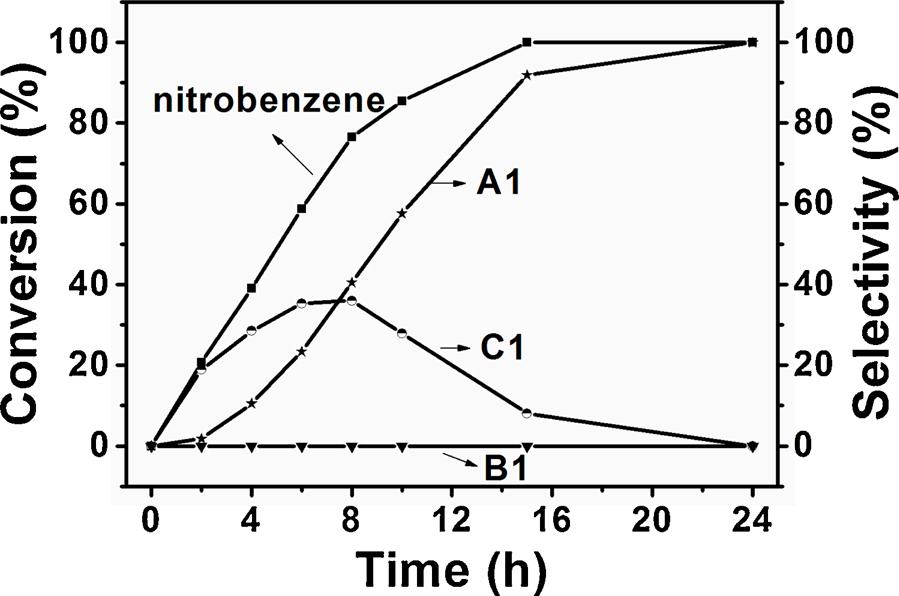
Fig. 7. Time-dependent catalytic performance in visible light promoted onepot hydrogenation and amidation of nitrobenzene with acetic acid over 3% Pt/N-TiO2/Ti3C. The reaction conditions are the same as in Table 1 entry 3.
Table 1
Visible light promoted one-pot hydrogenation and amidation of nitrobenzene with acetic acid over Pt NPs on N doped TiO2/MXene Ti3C2 heterojunctions.a
a Reaction conditions: nitrobenzene (1 mmol) K3PO4 (1 mmol) and solvent (3 mL) were stirred magnetically under 1 atm H2 in a reaction tube in the presence of Pt NPs on N doped TiO2/Ti3C2 heterojunction catalysts with sbustrate:Pt = 600 for 24 h, melamine:TiO2/Ti3C2 = 0.5:1 during the doping, 0.75 W cm 2 blue LED, no B1 was detected in Table 1, “ -” = no product or negligible product. b no K3PO4 c melamine:TiO2/Ti3C2 = 0.25:1 during the doping. d melamine:TiO2/ Ti3C2 = 1:1 during the doping. e 0.15 W cm 2 blue LED instead. f without visible light irradiation. g urea instead of melamine during the doping. h N-TiO2@C instead of N-TiO2/Ti3C.
Fig. 6. Transient photocurrent responses a) and electrochemical impedance spectroscopy b) of N-TiO2/Ti3C2, 3%Pt/N-TiO2/Ti3C2 and 3%Pt/N-TiO2@C.
H.
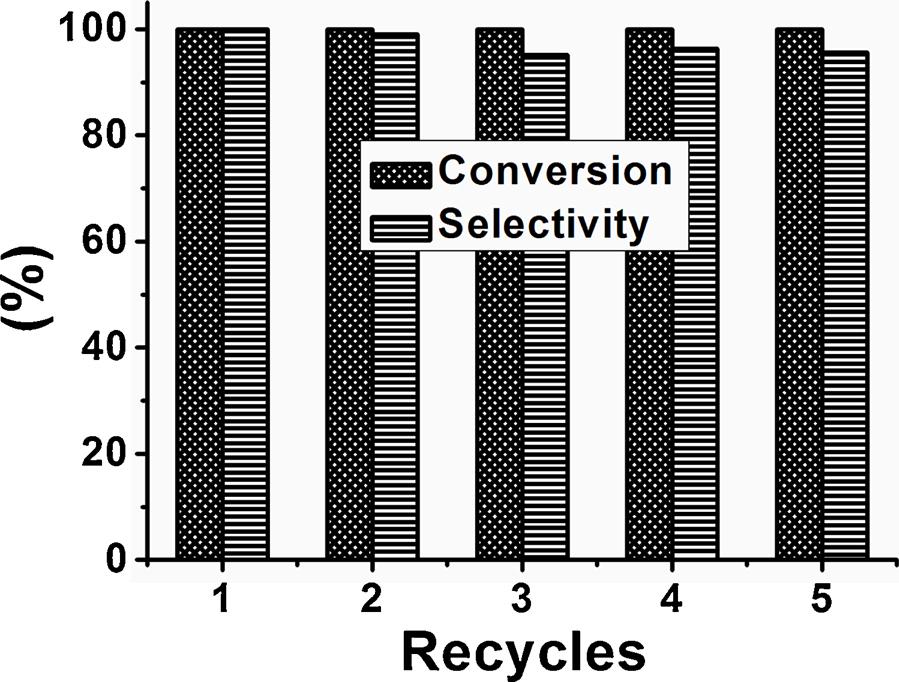
The as-prepared 3%Pt/N-TiO2/Ti3C catalyst was used for one-pot hydrogenation and amidation of nitro compounds with carboxylic acids under visible light irradiation. Nitrobenzene and acetic acid was chosen to test the catalytic performance (Table 1). No product was detected without catalyst (Table 1, entry 1). Without alkaline additive K3PO4, one-pot hydrogenation and amidation of nitrobenzene was absolutely converted but just with 64.0 % chemoselectivity to acetanilide (A1) (Table 1, entry 2), which suggested that the base was required for the deprotonation of amine [56]. The decreased conversion in the absence of base should be owing to aniline (a primary amine) itself could assist the progress of reaction by acting as a base. In the presence of K3PO4 additive, hydrogenation and amidation reaction could reach 100 % conversion with 100 % chemoselectivity to A1 (Table 1, entry 3). The amount of melamine used during TiO2/Ti3C doping was further optimized (Table 1, entries 3–5). When the melamine:TiO2/Ti3C2 increased from 0.25:1 to 0.5:1 during the doping, slightly increase in activity and chemoselectivity was observed. Further increase the melamine:TiO2/Ti3C2 ratio had no obvious influence on the catalytic performance. Above results indicated that N doping (N 2p generate new energy levels by hybridizing with O 2p, thus reducing the apparent band gap) with appropriate amount of melamine could effectively form hybrid energy levels in the TiO2 band gap [57]. To gain deep insight into the role of light on the reaction, we investigated the hydrogenation and amidation reaction with 0.15 W cm 2 blue LED, just 31.0 % conversion with 29.0 % chemoselectivity to A1 was achieved (Table 1, entry 6). The one-pot hydrogenation and amidation reaction could not be carried out

without visible light irradiation (Table 1, entry 7). For comparison, urea doped TiO2/Ti3C2 was also tested as the carrier, poor activity and moderate chemoselectivity to acetanilide was attained (Table 1, entry 8). In comparison with 3%Pt/N-TiO2/Ti3C, 3%Pt/N-TiO2@C reached 67.6 % conversion and 86.7 % chemoselectivity to A1. This result indicated that the combination of Ti3C, TiO2 and Pt NPs together with the formation of heterojunction, with Ti3C acting as a transporter for electrons to inhibit the backward diffusion of electrons, significantly improved one-pot nitrobenzene hydrogenation as well as amidation with acetic acid. We further monitored the reaction between nitrobenzene and acetic acid with 1 atm hydrogen over visible light promoted photocatalysis (Fig. 7). Nitrobenzene was firstly reduced to aniline intermediate followed closely with amidation. No other byproduct was detected. The 3%Pt/N-TiO2/Ti3C could be reused by straightforward centrifugation followed by vacuum drying. Catalyst could be recycled 5 times with no obvious activity and chemoselectivity decrease (Fig. 8). No obvious Pt loss was detected by ICP-OES in the reaction solution.
In the visible light induced 3%Pt/N-TiO2/Ti3C catalytic system, nitrobenzene one-pot hydrogenation and amidation with carboxylic acids could also be extended to various carboxylic acids (Table 2). 3% Pt/N-TiO2/Ti3C showed excellent activity and chemoselectivity to corresponding amides (>90 %) with acetic acid, propanoic acid, butyric acid, valeric acid as well as isobutyric acid (Table 2, entries 1, 3–6). However, formic acid, with lower pKa value of 3.77, gave lower chemoselectivity to the corresponding amide (Table 2, entry 2); meanwhile, octanoic acid gave a chemoselectivity of 27.9 % and aniline was the byproduct (Table 2, entry 7). Either the chemoselectivity decrease for formic acid or the photocatalytic decline for octanoic acid should be ascribed to the steric hindrance.
To further extend the scope of the use of aromatic nitro compounds in the one-pot hydrogenation and amidation with atmosphere H2 upon visible light irradiated 3%Pt/N-TiO2/Ti3C, other aromatic nitro compounds having different substituents were chosen as substrates (Table 3), good to excellent activity and chemoselectivity were achieved. When the aromatic nitro compounds all had methyl substituent (Table 3, entries 2–4), the chemoselectivity order, o-nitrotoluene < mnitrotoluene < p-nitrotoluene, should be ascribe to the steric hindrance effect. As for stronger electron-donating methoxy substituent substrates, o-nitroanisole showed 99.8 % chemoselectivity to corresponding amide (Table 3, entry 5). However, only 85.3 % chemoselectivity was obtained with p-nitroanisole (Table 3, entry 6), this should be explained that both electron donating as well as steric hindrance effect were favorable for the p-nitroanisole conversion, and the monoamidation product was further converted into bisamidation product (Table 3, entry 6). For the electron withdrawing group substituted nitrobenzenes, the slightly chemoselectivity decrease to corresponding amides should be owing to the electronic effect (Table 3, entries 7–9). Additionally, m-
a The reaction conditions were the same as in Table 1 (entry 3) except the carboxylic acids.
Fig. 8. Cycling visible light promoted one-pot hydrogenation and amidation of nitrobenzene with acetic acid over 3%Pt/N-TiO2/Ti3C. The reaction conditions are the same as in Table 1 entry 3.
Table 2
Visible light promoted one-pot hydrogenation and amidation of nitrobenzene with carboxylic acids over 3%Pt/N-TiO2/Ti3C.a
Visible light promoted one-pot hydrogenation and amidation of nitroaromatics with acetic acid over 3%Pt/N-TiO2/Ti3C.a
a The reaction conditions were the same as in Table 1 (entry 3) except the nitroaromatics.
nitroacetophenone and p-nitrobenzaldehyde could be converted to corresponding amides with 89.5 % and 98.5 % chemoselectivity respectively (Table 3, entries 10–11).
Some experiments were carried out to explore the photocatalytic one-pot hydrogenation and amidation reaction mechanism (Table 4). Rather low photocatalytic activity and chemoselectivity to A1 were achieved with 3%Pt/Ti3C2 (Table 4, entry 2), which indicated that the introduction of doped TiO2 in the catalytic system was necessary for the efficient light utilization. In comparison with 3%Pt/N-TiO2/Ti3C2, 3% Pt/N-TiO2@C exhibited lower activity and chemoselectivity to A1 (Table 4, entry 3 vs 1), which should be explained that Ti3C2 acted as a transporter for electrons to accelerate the nitrobenzene one-pot hydrogenation and amidation with acetic acid. When e scavenger KBrO3 was introduced to the catalytic system, photocatalytic activity was obviously decreased (Table 4, entry 4), and nitrobenzene reduction should be accelerated by photogenerated electrons. On the other hand, when h+ scavenger TEOA was introduced to the catalytic system,
chemoselectivity to A1 was decreased (Table 4, entry 5), therefore, amidation step should be promoted by photogenerated holes in some degree. When acetic acid and H2O were used as the reaction solvent, amidation step was obviously inhibited (Table 4, entry 6), which evidenced that photocatalytic amidation step went through a dehydration process. Considering the reaction temperature might have decisive influence on the chemoselectivity in the hydrogenation and amidation catalytic reaction [22], we further tested the thermal catalytic performance of 3%Pt/D-TiO2/Ti3C2 at 60 ◦ C or 80 ◦ C (Table 4, entries 7–8). Rather low activity with complete chemoselectivity to aniline was obtained at 60 ◦ C; and just 12.6 % conversion and 47.6 % chemoselectivity to amidation product was attained at 80 ◦ C. Considering the actual photocatalytic system temperature was lower than 60 ◦ C with the LED irradiation, the excellent photocatalytic one-pot hydrogenation and amidation performance should reasonably be attributed to the improved catalytic system activation efficiency with visible light.
To gain insight view about how the catalytic system achieved highly Table 3
Table 4
Experimental probes on one-pot hydrogenation and amidation reaction mechanism.a
1
3
4
5
6
7
8
a The reaction conditions were the same as in Table 1 entry 3.
Fig. 9. In situ DRIFTS spectra for one-pot hydrogenation and amidation of aniline with acetic acid over 3%Pt/N-TiO2/Ti3C2 and 3%Pt/N-TiO2@C under visible light irradiation or heating.
efficient activation under the visible light irradiation, we used the in situ diffuse reflectance infrared fourier transform spectroscopy (DRIFTS) to dynamically observe along with analyze the primary difference in amidation activation of the catalytic system over 3%Pt/N-TiO2/Ti3C2 and 3%Pt/N-TiO2@C under visible light irradiation or heating (Fig. 9). The baseline spectrum was tested before light irradiation or heating. The following characteristic peaks decrease was primary observed in the in situ DRIFTS with light irradiation or heating. The absorption peak around 850 cm 1 was the out-of-plane deformation vibration of N–H bond in substrate aniline; the absorption at about 1100 cm 1 was the hydroxyl group deformation vibration in carboxylic acid; the absorption at about 1570 cm 1 was the in-plane deformation vibration of N–H; 1700 cm 1 was the telescopic vibration of C–– O in carboxylic acid and the absorption peak between 3500 cm 1 and 3900 cm 1 was N–H telescopic vibration [58,59]. In the presence of 3%Pt/N-TiO2/Ti3C2 catalyst at 50 ◦ C, hydroxyl group deformation vibration, N–H in-plane deformation vibration, C–– O telescopic vibration as well as N–H telescopic vibration, which were related to the amidation catalytic activation, gradually weakened with the increase of heating time. On the other side, the decrease in deformation vibration of hydroxyl group, in-plane deformation vibration of N–H bond, telescopic vibration of C–– O as well as telescopic vibration of N–H under visible light irradiation at 25 ◦ C was much faster than heating. In addition, the decrease in out-of-plane deformation vibration of N–H bond in substrate aniline was also observed under visible light irradiation. The comparison of
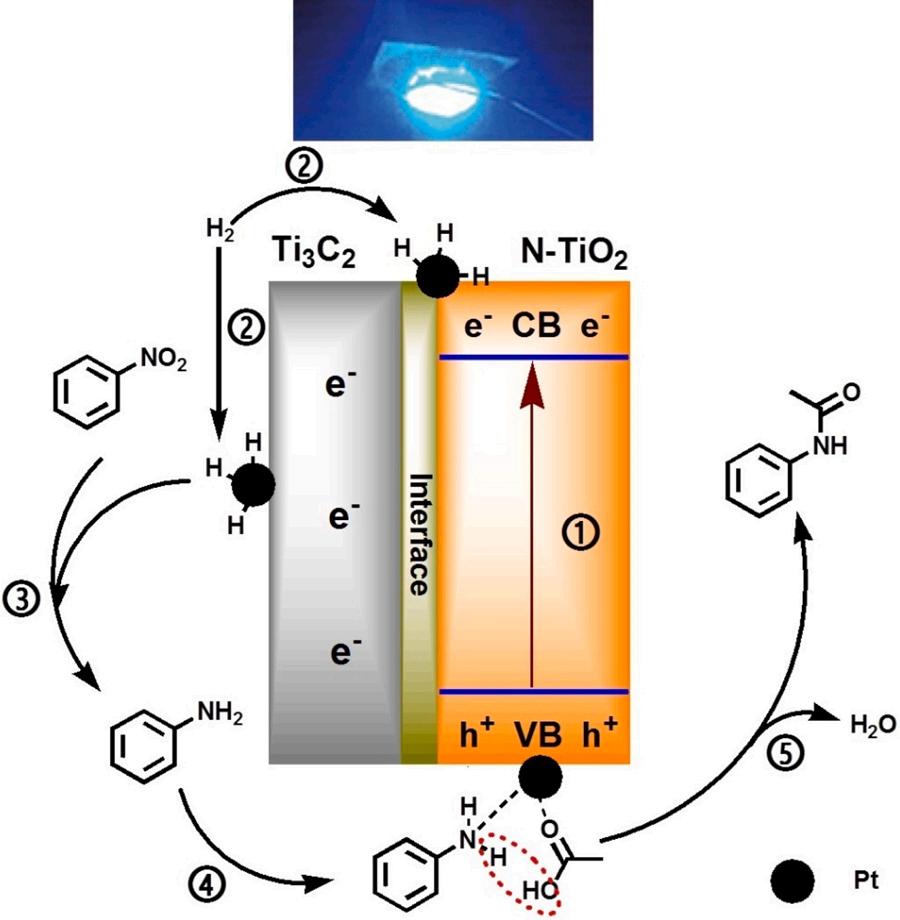
Scheme 1. Proposed mechanism for visible light promoted one-pot hydrogenation and amidation of nitrobenzene with acetic acid over 3%Pt/N-TiO2/Ti3C.
visible light illumination and heating in catalytic system indicated that the visible light irradiation promoted catalytic activation efficiency of both aniline and carboxylic acid, which should be the basic reason for the evident selective amidation catalytic efficiency improvement under visible light irradiation. 3%Pt/N-TiO2@C catalyst was also tested under similar conditions. Without the Ti3C2 electron transporter, the decrease in in-plane deformation vibration of N–H bond, telescopic vibration of C–– O in carboxylic acid as well as telescopic vibration of N–H became not that obvious, indicating the decrease in the amino and carboxyl group activation and leading to lower amidation catalytic efficiency.
Based on above discussion, visible light promoted hydrogenation and amidation of nitrobenzene with acetic acid over 3%Pt/N-TiO2/Ti3C2 was given (Scheme 1). Electrons and holes could be generated with visible light irradiation of N-TiO2/Ti3C2 Short-range charge directional transmission construction with electron transporter Ti3C and metal NPs supported on N-TiO2/Ti3C2 could lead to efficient electron transfer from excited N-TiO2/Ti3C2 to metal NPs [43,60]. Electron-rich Pt specie was formed by the transfer of photogenerated electrons to Pt nanoparticles with visible-light irradiation of 3%Pt/N-TiO2/Ti3C2 (①); Hydrogen from H–H bond cleavage (②) was transferred to electron-rich Pt to form Pt hydride, and then the selective hydrogenation of nitro was conducted (③). Considering the N–H, C–– O as well as O–H activation observed with in situ DRIFTS spectra, the amidation activation model was proposed on Pt NPs (④): Absorbed aniline could be activated by photoinduced holes on the valance band [61]; and holes left on the 3% Pt/N-TiO2/Ti3C2 support could also assist the cleavage of the C–OH bond in carboxyl group [62]. With the synergy action of visible light, Pt NPs as well as holes generated with visible light irradiation, the intermediate removed water to realize the amidation conversion (⑤).
Conclusion
Pt nanoparticles supported on N doped titanium dioxide/titanium carbide (MXene) (3%Pt/N-TiO2/Ti3C2) heterojunctions, formed by in situ grew TiO2 on Ti3C2 nanosheets, N doped TiO2 with melamine, and then Pt nanoparticles with small diameter well dispersed on N-TiO2/ Ti3C2, were employed as photocatalysts for the tandem reactions between aromatic nitro compounds and carboxylic acids to produce amide products. In comparison with the excellent amidation activity and chemoselectivity over 3%Pt/N-TiO2/Ti3C2, Pt nanoparticles on N doped titanium dioxide prepared from titanium carbide (3%Pt/N-TiO2@C) had
H.
apparently decreased activity and chemoselectivity to amides. The improved catalytic performance over 3%Pt/N-TiO2/Ti3C2 was ascribed to the improvement in photogenerated electron and hole separation efficiency through charge short-range directional transmission caused by the intimate contact between the TiO2 and the conductive Ti3C2 The waste-free catalytic manner to direct hydrogenation along with amidation between nitroaromatics and carboxylic acids was achieved via a successful coupling of the 2D transition metal carbide/carbonitride based photocatalysis, Ti3C2 based short-range directional charge transmission as well as Pt NPs based hydrogenation along with amidation under rather mild conditions. In situ DRIFTS spectra further verified that the amidation activation with visible light irradiation at 25 ◦ C was much faster than heating. This work also shed light on the infinite possibilities for development multifunctional catalysis for a broad range of visiblelight promoted organic transformations.
CRediT authorship contribution statement
Heyan Jiang: Conceptualization, Investigation, Data curation, Writing - review & editing, Funding acquisition. Zujie Hu: Investigation, Data curation. Chuan Gan: Investigation, Validation. Bin Sun: Conceptualization, Methodology. Shuzhen Kong: Supervision, Funding acquisition. Fengxia Bian: Supervision, Funding acquisition.
Declaration of Competing Interest
The authors declare that they have no known competing financial interests or personal relationships that could have appeared to influence the work reported in this paper.
Acknowledgements
This work was financially supported by Natural Science Foundation Project of CQ (No. cstc2018jcyjAX0735, cstc2019jcyj-msxmX0641, cstc2015jcyjBX0031), National Natural Science Foundation of China (No.21201184), Ministry of Education of Chongqing (No. KJQN201900811), Chongqing Technology and Business University (950119090) and Chongqing Key Laboratory of Catalysis and New Environmental Materials (KFJJ2019082), Key Disciplines of Chemical Engineering and Technology in Chongqing Colleges and Universities during the 13th Five Year Plan and Innovation Group of New Technologies for Industrial Pollution Control of Chongqing Education Commission (CXQT19023).
Appendix A. Supplementary data
Supplementary material related to this article can be found, in the online version, at doi:https://doi.org/10.1016/j.mcat.2021.111490.
References
[1] V.R. Pattabiraman, J.W. Bode, Nature 480 (2011) 471–479
[2] M.T. Sabatini, L.T. Boulton, H.F. Sneddon, T.D. Sheppard, Nat. Catal. 2 (2019) 10–17
[3] R.M. de Figueiredo, J.S. Suppo, J.M. Campagne, Chem. Rev. 116 (2016) 12029–12122
[4] R.N. Lima, C.S. dos Anjos, E.V.M. Orozco, A.L.M. Porto, Mol. Catal. 466 (2019) 75–105.
[5] E. Bouron, G. Goussard, C. Marchand, M. Bonin, X. Pannecoucke, J.C. Quirion, H. P. Husson, Tetrahedron Lett. 40 (1999) 7227–7230
[6] U. Ragnarsson, L. Grehn, Acc. Chem. Res. 31 (1998) 494–501
[7] F. Fazio, C.H. Wong, Tetrahedron Lett. 44 (2003) 9083–9085
[8] L.J. Goossen, D.M. Ohlmann, P.P. Lange, Synthesis (2008) 160–164
[9] L. Perreux, A. Loupy, F. Volatron, Tetrahedron 58 (2002) 2155–2162
[10] H. Charville, D. Jackson, G. Hodges, A. Whiting, Chem. Commun. 46 (2010) 1813–1823
[11] F. De Schouwer, L. Claes, A. Vandekerkhove, J. Verduyckt, D.E. De Vos, ChemSusChem 12 (2019) 1272–1303
[12] V.V. Gaikwad, P.A. Mane, S. Dey, D. Patel, B.M. Bhanage, Mol. Catal. 482 (2020), 110672
[13] X. Wang, Nat. Catal. 2 (2019) 98–102
[14] H. Lundberg, F. Tinnis, N. Selander, H. Adolfsson, Chem. Soc. Rev. 43 (2014) 2714–2742
[15] Z. Dong, Z. Ren, S.J. Thompson, Y. Xu, G. Dong, Chem. Rev. 117 (2017) 9333–9403
[16] Y.C. Chu, S.W. Bi, X.H. Wu, Y.Y. Jiang, Y.X. Liu, B.P. Ling, X.A. Yuan, Mol. Catal. 497 (2020), 111222
[17] K.D. Schleicher, T.F. Jamison, Org. Lett. 9 (2007) 875–878
[18] C. Zhang, J. Liu, C. Xia, Catal. Sci. Technol. 5 (2015) 4750–4754
[19] K. Ishihara, S. Ohara, H. Yamamoto, J. Org. Chem. 61 (1996) 4196–4197
[20] T.B. Nguyen, J. Sorres, M.Q. Tran, L. Ermolenko, A. Al-Mourabit, Org. Lett. 14 (2012) 3202–3205
[21] H. Charville, D. Jackson, G. Hodges, A. Whiting, Chem. Commun. 46 (2010) 1813–1823.
[22] M. Li, L. Hu, X.Q. Cao, H.Y. Hong, J.M. Lu, H.W. Gu, Chem. Eur. J. 17 (2011) 2763–2768
[23] C.J. Clarke, W.C. Tu, O. Levers, A. Brohl, J.P. Hallett, Chem. Rev. 118 (2018) 747–800
[24] N. Lucas, L. Gurrala, S.B. Halligudi, Mol. Catal. 490 (2020), 110966
[25] H. Ghafuri, G. Jafari, A. Rashidizadeh, F. Manteghi, Mol. Catal. 475 (2019), 110491
[26] A.H. Chowdhury, I.H. Chowdhury, S. Biswas, S.M. Islam, Mol. Catal. 493 (2020), 111050
[27] S. Zhang, J. Xu, H. Cheng, C. Zang, B. Sun, H. Jiang, F. Bian, Appl. Catal. A Gen. 596 (2020), 117536
[28] H. Jiang, J. Xu, S. Zhang, H. Cheng, C. Zang, F. Bian, Catal. Sci. Technol. 10 (2020), https://doi.org/10.1039/D0CY01881C
[29] H. Cheng, X. Long, F. Bian, C. Yang, X. Liu, H. Jiang, J. Catal. 389 (2020) 121–131
[30] J. Xu, S. Zhang, X. Liu, F. Bian, H. Jiang, Catal. Sci. Technol. 9 (2019) 6938–6945
[31] S. Song, J.F. Qu, P.J. Han, M.J. Hulsey, G.P. Zhang, Y.Z. Wang, S. Wang, D.Y. Chen, J.M. Lu, N. Yan, Nat. Commun. 11 (2020) 4899
[32] M. Naguib, O. Mashtalir, J. Carle, V. Presser, J. Lu, L. Hultman, Y. Gogotsi, M. W. Barsoum, ACS Nano 6 (2012) 1322–1331
[33] M. Naguib, V.N. Mochalin, M.W. Barsoum, Y. Gogotsi, Adv. Mater. 26 (2014) 992–1005
[34] M. Nasrollahzadeh, Z. Nezafat, M.G. Gorab, M. Sajjadi, Mol. Catal. 484 (2020), 110758
[35] B. Anasori, M.R. Lukatskaya, Y. Gogotsi, Nat. Rev. Mater. 2 (2017) 16098.
[36] M. Ming, Y. Ren, M. Hu, Y. Zhang, T. Sun, Y. Ma, X. Li, W. Jiang, D. Gao, J. Bi, G. Fan, Appl. Catal. B 210 (2017) 462–469
[37] G.Y. Fan, X.J. Li, Y.L. Ma, Y. Zhang, J.T. Wu, B. Xu, T. Sun, D.J. Gao, J. Bi, New J. Chem. 41 (2017) 2793–2799
[38] T.P. Nguyen, D.M.T. Nguyen, D.L. Tran, H.K. Le, D.V.N. Vo, S.S. Lam, R.S. Varma, M. Shokouhimehr, C.C. Nguyen, Q.V. Le, Mol. Catal. 486 (2020), 110850
[39] H. Jiang, C. Zang, Y. Zhang, W. Wang, C. Yang, B. Sun, Y. Shen, F. Bian, Catal. Sci. Technol. 10 (2020) 5964–5972
[40] X. Chia, M. Pumera, Nat. Catal. 1 (2018) 909–921
[41] T. Su, R. Peng, Z.D. Hood, M. Naguib, I.N. Ivanov, J.K. Keum, Z. Qin, Z. Guo, Z. Wu, ChemSusChem 11 (2018) 688–699
[42] C. Peng, X.F. Yang, Y.H. Li, H. Yu, H.J. Wang, F. Peng, ACS Appl. Mater. Inter. 8 (2016) 6051–6060
[43] Y. Xu, S. Wang, J. Yang, B. Han, R. Nie, J. Wang, J. Wang, H. Jing, Nano Energy 51 (2018) 442–450
[44] Q. Liu, L. Ai, J. Jiang, J. Mater. Chem. A 6 (2018) 4102–4110
[45] R. Asahi, T. Morikawa, T. Ohwaki, K. Aoki, Y. Taga, Science 293 (2001) 269–271
[46] Z. Zhang, Z. Huang, X. Cheng, Q. Wang, Y. Chen, P. Dong, X. Zhang, Appl. Surf. Sci. 355 (2015) 45–51
[47] J.I. Chen, E. Loso, N. Ebrahim, G.A. Ozin, J. Am. Chem. Soc. 130 (2008) 5420–5421
[48] Q. Sun, J. Wang, X. Wang, J. Dai, X.S. Wang, H.C. Fan, Z.W. Wang, H. Li, X. Huang, W. Huang, Nanoscale 12 (2020) 16987–16994
[49] B.Y. Xia, B. Wang, H.B. Wu, Z. Liu, X. Wang, X.W. Lou, J. Mater. Chem. 22 (2012) 16499–16505.
[50] Y. Wei, J. Jiao, Z. Zhao, W. Zhong, J. Li, J. Liu, G. Jiang, A. Duan, J. Mater. Chem. A 3 (2015) 11074–11085
[51] D. Ma, Y. Xin, M. Gao, J. Wu, Appl. Catal. B 147 (2014) 49–57
[52] Z. Huang, Z. Gao, S. Gao, Q. Wang, Z. Wang, B. Huang, Y. Dai, Chinese J. Catal. 38 (2017) 821–830
[53] P. Dhanasekaran, S.V. Selvaganesh, S.D. Bhat, J. Power Sources 304 (2016) 360–372
[54] W. Yuan, L. Cheng, Y. Zhang, H. Wu, S. Lv, L. Chai, X. Guo, L. Zheng, Adv. Mater. Interfaces (2017), 1700577
[55] S. Zhang, J. Xu, H. Cheng, C. Zang, F. Bian, B. Sun, Y. Shen, H. Jiang, ChemsusChem 13 (2020) 5264–5272
[56] S. Karthik, R. Sreedharan, T. Gandhi, ChemistrySelect 4 (2019) 175–180
[57] R. Asahi, T. Morikawa, T. Ohwaki, K. Aoki, Y. Taga, Science 293 (2001) 269–271
[58] V. Gupta, N. Chaudhary, R. Srivastava, G.D. Sharma, R. Bhardwaj, S. Chand, J. Am. Chem. Soc. 133 (2011) 9960–9963
[59] Z. Li, W.T. Tysoe, Sur. Sci. 606 (2012) 1934–1941
[60] D.R. Sun, W.J. Liu, Y.H. Fu, Z.X. Fang, F.X. Sun, X.Z. Fu, Y.F. Zhang, Z.H. Li, Chem. Eur. J. 20 (2014) 4780–4788
[61] W. Phasayavan, M. Japa, S. Pornsuwan, D. Tantraviwat, F. Kielar, V.B. Golovko, S. Jungsuttiwong, B. Inceesungvorn, J. Colloid Interf. Sci. 581 (2021) 719–728
[62] Z.F. Jiao, Y.M. Tian, B. Zhang, C.H. Hao, Y. Qiao, Y.X. Wang, Y. Qin, U. Radius, H. Braunschweig, T.B. Marder, X.N. Guo, X.Y. Guo, J. Catal. 389 (2020) 517–524
Other documents randomly have different content
den volgenden morgen vlogen er een menigte papegaaien over zijn hut. Zijn kinderen maakten hem er opmerkzaam op en hij had nog juist tijd, de vogels toe te roepen, een zaad van zekeren boom te laten vallen, van wiens bast de Indiaansche medicijnmeesters bij hunne genezingen gebruik maken. De vogels voldeden onmiddellijk aan het verzoek en hoewel de jongens het zaad hadden zien vallen, konden zij het nergens vinden.
Hariwali had er echter dadelijk zijn voet op gezet. Daar kinderen er niets meê te maken hadden, wat hij ging doen, zei hij, dat er geen zaad gevallen was en dat zij zich zoo gauw mogelijk moesten verwijderen. Het jonge volk mag immers niet zien wat de oude piaiman voor kunsten uitvoert!
Zoodra Hariwali alleen was, legde hij het zaad in den grond, op dezelfde plek, waar het was neêrgevallen, en nadat hij den zelfden avond zijn tooverkunsten met den rammelaar herhaald had, stond den volgenden morgen op de plek een statige boom. Zoodra Hariwali nu de vrucht van zijn kunde had gezien, riep hij zijn moeder, wie hij gelastte, alles wat zij bij elkander had gepakt, aan de takken van den boom te hangen, en te wachten, tot hij met zijn broeder zou terugkeeren.
Zoodra hij nu op de woonplaats van Jawahoe was aangekomen, waar hij de geheele familie afwezig vond, nam [102]hij zijn gevangen broeder uit de hangmat, trok den bundel beenderen van het bladerdak der hut en maakte, dat hij met zijn last wegkwam. Maar ongelukkig kwam de Geest eerder terug, dan hij gedacht had, en deze, ziende dat de hangmat leeg was en de beenderen verdwenen waren, begreep dadelijk, wat er gebeurd was. Hij ontdekte spoedig het versche spoor en zond zijn honden vooruit, om de vluchtelingen op te sporen. Arme Hariwali, arme broêr! Deze hoorden het blaffen van de honden en het fluiten van den Geest, maar zij hadden nog juist den tijd, om in het hol van een armadil* te kruipen. Pas waren zij er in, of Jawahoe kwam aanrennen, die hen toeriep, onmiddellijk te voorschijn te komen, want anders zou hij hen met een stok doorboren. De vluchtelingen lagen
echter diep en laag en antwoordden niet. Jawahoe, daarop woedend geworden, bracht een stok met een harden stoot in het hol, maar Hariwali greep hem vast en veranderde het harde voorwerp onmiddellijk in een kapassi-slang*.
Jawahoe nu, denkende, toen hij de slang zag, dat hij zich vergist had en het spoor der vluchtelingen kwijt was geraakt, verwijderde zich nu en ging elders zoeken. Toen Hariwali zich overtuigd had, dat het gevaar voorbij was, plaatste hij de beenderen weêr in het lichaam van zijn broeder en toog met hem op weg naar zijn dorp.
Hoe verheugd was zijn moeder, haar beide zoons weêr te zien! Zij had inmiddels alles aan de takken van den zwaren boom opgehangen, en had zich met haar dochter en kleinkinderen voor een lange reis gereed gemaakt. Toen het avond begon te worden, klommen zij allen, groot en klein in de onderste takken, waarop zij beschutting vonden onder het dichte gebladerte, terwijl Hariwali nog hooger klom en hier met zijn tooverrammelaar begon te werken.
Midden in den nacht voelde de familie beneden plotseling, [103]dat de boom begon te schudden; zij hoorde rommelende geluiden, gevolgd door trillingen, en kregen de gewaarwording, dat de boom zijn wortels uit den zandachtigen bodem begon los te maken, en op het punt was, er vandoor te gaan.44 Juist waren ze voornemens de lange reis te ondernemen, toen Hariwali’s zuster, haar oogen naar beneden richtend, zich herinnerde, dat zij haar kwejoe* in de hut had achtergelaten. Zij riep haar broeder boven in den boom toe: Dekeweyo-daiba (ik heb mijn voorschoot vergeten) en toen zij ten antwoord kreeg, dat zij het moest gaan halen, veranderde zij op het oogenblik, dat zij haar hut had bereikt, in een wicissi-eend*. Nog altijd kan men deze eend „dekeweyodaiba” hooren roepen, hoewel niet zoo duidelijk, als wanneer de woorden langzaam zouden worden uitgesproken.
Wat de rest van de familie betreft—wel, wij weten, dat de boom ergens heen vloog, maar nooit hebben wij iets van de menschen vernomen, die
er op waren, toen hij van de plaats, waar hij zoo gauw gegroeid was, vertrok.
No. 17. De legende van den Ouden man’s val.
In lang vervlogen tijden, zoo vertellen onze voorouders, bevonden zich boven den Potaro-val* meerdere Indianen-dorpen. In een der hutten woonde een oude man, die half blind en een ieder tot last was. Want, hoewel hij vroeger sterk en vlug was geweest, werden zijn arme lijdende voeten door een menigte zandvlooien* geplaagd, die er zich venijnig hadden ingegraven. De oude, hulpelooze man had steeds meer verzorging noodig—en dit verdroot den jongeren, die er ten slotte de brui van gaven en uitriepen: „Wat helpt dat? Laten we hem laten liggen en laat hem maar schreeuwen! Wie er lust in heeft, ga zijn gang. Hij is een lastige, afzichtelijke oude man [104]geworden. Wat is er aan te doen? Allen wenschen zijn dood”. Niemand wilde echter het hoofd van den armen man klieven. „Laat hij gaan naar het land der Geesten”, riepen sommigen, „de rivier zal hem er wel brengen; als zijn lijden nog langer voortduurt, zal hij toch sterven. Wij kunnen hem niet meer helpen; wij zondigen dus niet”.
Toen zei de kapitein: „Breng een korjaal,45 leg er den oude in, maar verzuim vooral niet, al hetgeen hij bezit er ook in te leggen; laat hier niets van hem achterblijven, want wij wenschen geen voordeel, doch willen alleen aan zijn lijden een einde maken. Wij zenden hem naar een andere wereld, en laten hem niet met ledige handen gaan; want anders zouden we zondigen”.
De jongeren gehoorzaamden. Zij brachten den gevraagden korjaal, legden den ouden man met zijn bezittingen er in, duwden het vaartuigje vooruit en zagen hem langzaam stroomafwaarts drijven. Het geraas van den naderenden waterval moet voor hem een benauwende droom geweest zijn, maar zijn angst duurde niet lang, want—slechts eenige
oogenblikken daarna stortte het bootje met het slachtoffer en al zijn zandvlooien naar omlaag.
… slechts eenige oogenblikken daarna stortte het bootje met het slachtoffer en al zijn zandvlooien omlaag. Zie blz. 104.
Het kan zijn, dat het jonge volk, dat zoo wreed was geweest, spijt heeft gehad, niet anders gehandeld te hebben; het is niet bekend, want het is al heel, heel lang geleden. Maar wel weten we, dat de klokkenvogel*, met zijn wit gevederte, in de buurt nog altijd voortgaat, des nachts zijn klokkentonen te laten hooren.
Sommige Indianen weten echter te vertellen, dat toen de man de afschuwelijke tuimeling over den val maakte, onzichtbare krachten tusschenbeide gekomen zijn, die, om zijn arm gebeente te redden, boot, met alles wat er in was, in steenen veranderd hebben. Ieder, die de rotsen [105]daar nu ziet, zal de boot in de gedaante van een puntigen rots duidelijk herkennen en, niet ver van daar, de in steen veranderde pagaai. Het is echter niet zoo duidelijk, waar de man zelf gebleven is. „Want”, beweren de Indianen, die beneden den val wonen, „daar een sterke stroom de hardste rotsen afslijpt, zullen eerst zijn ooren en zijn neus, vervolgens zijn vingers en zijn teenen afgeslepen zijn, zoodat zijn lichaam misschien in het zand beneden den val is overgegaan”.
No. 18. Amanna en haar praatzieke man. (C.)
Verhit door den drank van een groot paiwarri-feest, nam een Indiaan zijn weg naar het water, om zich te baden en wat op te frisschen. Toen hij er aankwam, ontmoette hij Amanna, een van de geesten der Okoyoemo’s, een aantrekkelijke jonge vrouw, die hem vroeg, haar in het water te vergezellen. Eerst had hij er wel wat op tegen, maar toen zij bleef aanhouden, kon hij ten slotte niet langer aan haar bekoorlijkheden weêrstand bieden. Toen hij op het laatste oogenblik toch niet nalaten kon, haar toe te voegen, dat hij er haast zeker van was, dat men hem zou willen verdrinken, voegde zij hem toe: „Wees niet bevreesd, ik zal goed op je passen en zorgen, dat er geen kwaad
met je gebeuren kan”. Zij doken nu samen onder, en toen zij op den bodem van het water aankwamen, zag hij een aantal hutten, vol met volk, waaronder vele jonge vrouwen. Hij voelde zich nu erg tevreden, vooral toen deze hem drank aanboden. Amanna verbood hem er echter van te gebruiken en nam hem meê naar haar ouden vader, die hem hartelijk verwelkomde en zijn dochter op het hart drukte, goed op hem te letten.
Dit deed zij ook.
In dien tusschentijd was de moeder over het lange wegblijven van haar zoon ongerust geworden; zij volgde [106]het spoor, dat helaas naar de rivier leidde. „Mijn arme zoon zal verdronken zijn”, dacht zij, en zij begon naar zijn lijk te zoeken. Maar overal te vergeefs. Zij keerde bedroefd naar haar dorp terug, in de vaste meening, dat haar zoon dood was.
Geruimen tijd was er voorbijgegaan, toen de man het verlangen kreeg, om zijn moeder een bezoek te brengen. Hij rees uit het water omhoog en sloeg den weg in naar zijn oude woonplaats. De moeder, verheugd haar zoon weêr te zien, vroeg hem, waar hij al dien tijd was geweest; en hij vertelde, dat hij een verre wandeling had gemaakt. De oude vrouw was echter met dit antwoord niet tevreden, en zei tot haar zoon: „Je moet niet meer van me weggaan, want ik ben oud en lijd honger; je jongere broêr kan mij niet ondersteunen en ik heb geen andere kinderen dan jelui beiden”.
Maar haar zoon, die een wilden aard had, luisterde niet en vertrok nog dienzelfden namiddag naar zijn vrouw, de Watergeest, terug. Ditmaal bleef hij nog veel langer weg dan de eerste maal. Toen hij nu na zijn tweede afwezigheid weêr eens naar zijn moeder kwam zien, vond hij haar met zijn kleinen broêr weêr aan het drinken van paiwarri. De jongen begon hem uit te vragen, waarom hij toch bij het Okoyoemo-volk verblijf hield. Dit verontrustte hem, en onder het uitroepen van: „Hoe
durf je me zoo’n vraag te doen?” holde hij weg en verdween hij weêr onder water, waar hij nog langer bleef dan den tweeden keer.
Er verliep nu weêr een lange tijd, gedurende welke Amanna hem drie kinderen had geschonken, en toen de man weêr zijn wensch te kennen gaf, zijn moeder te willen bezoeken, voegde hij er bij, dat hij graag zou zien, dat Amanna hem vergezelde. Zij vond het goed, op voorwaarde, dat de kinderen thuis zouden blijven. [107]
Toen het paar in de ouderlijke hut aankwam, was de oude moeder met haar zoon weêr bezig met het drinken van paiwarri, maar ditmaal was de broêr bepaald dronken, en weêr kon deze niet laten de vraag te doen, of hij onder het Okoyoema-volk bleef wonen? Ja, dat doe ik, zei de man geprikkeld, en hier heb je mijn vrouw Amanna, die tot die natie behoort!
Zoodra Amanna dit hoorde, holde zij naar de waterkant, en plonste zij onder water. Haar man vluchtte haar na, maar niet zoodra was hij ook onder water gekomen, of zijn vrienden en verwanten vermoordden hem, omdat hij aan zijn moeder haar naam had genoemd, en verteld had, waar zij van daan kwam.
No. 19. De zon en zijn beide tweelingzoons. (C.)
Zeer lang geleden leefde er een vrouw, aan wie de Zon* een tweeling schonk. Het waren jongens, Pia en Makoenaima* genoemd. Eens op een dag zei de toen nog niet geboren Pia tot zijn moeder: „Laten wij gaan en onzen vader gaan opzoeken. Wij zullen U den weg wijzen, en als wij op pad zijn, moet gij voor ons mooie bloemen plukken.” De moeder liep naar het Westen46 om haar man te ontmoeten, en terwijl zij aan het bloemen plukken was, struikelde zij, waardoor zij zich verwondde en viel. Zij betichtte nu van dit ongeluk hare nog ongeboren
kinderen; en nadat zij hen beknord had en hun vroeg, welken weg zij verder moest volgen, weigerden zij het te zeggen.
Zoo kwam het, dat zij een verkeerden weg insloeg en eindelijk met den gewonden voet en doodmoe aan een [108]vreemdsoortige hut kwam. De hut was het eigendom van Tijger’s moeder, Kono(bo)-aroe, de Regenkikvorsch*, en toen de uitgeputte wandelaarster ontdekte waar zij was, zei ze tot de oude vrouw, dat zij groote spijt had, hier gekomen te zijn, daar zij gehoord had, hoe wreed haar zoon was. De huisvrouw, die medelijden met haar had, beduidde haar, dat zij niet bang behoefde te zijn, maar verborg haar voor alle veiligheid in den kassiripot en smeet haastig het deksel er op.
Toen Tijger des nachts thuis kwam, begon hij overal rond te snuiven. „Moeder”, zei hij, „ik ruik iemand, wie heb je hier?” En ofschoon zij volhield, dat zij niemand voor hem had, om zijn maal te doen, was Tijger niet tevreden en ging zelf op onderzoek uit. Eindelijk ontdekte hij het angstige schepsel in den kassiri-pot.
Toen hij nu de arme vrouw met één slag gedood had, ontdekte hij de nog niet geboren kinderen. Hij toonde ze aan zijn moeder, die hem aanried, goed op ze te passen en ze zorgvuldig te verplegen. Tijger deed wat hem gezegd was: hij wikkelde ze in een bundel katoen, om ze warm te houden en ziet, den volgenden morgen waren ze al zóó groot geworden, dat ze begonnen te kruipen. Nog een dag later waren ze nog meer gegroeid, en dat ging zoo voort, tot dat ze reeds na verloop van een maand volwassen waren.
Tijger’s moeder zei, dat zij nu wel pijl en boog zouden kunnen hanteeren, waarmede zij den powies* moesten schieten, omdat het deze vogel was geweest, die hun moeder gedood had.
Pia and Makoenaima gingen nu de volgenden dag op jacht en schoten een powies. Dat ging lang goed; iederen dag brachten zij powies mede. Maar toen zij weêr eens op een powies mikten, riep den vogel hen toe,
dat het niet een powies was geweest, die hun moeder gedood [109]had, maar Tijger zelf, terwijl hij er de noodige inlichtingen bij gaf, hoe zij Tijger moesten dooden.
De beide jongens schrokken hevig, toen zij dit hoorden. Zij spaarden den vogel; maar toen zij met leêge handen van de jacht terugkwamen, maakten zij hun moeder wijs, dat de powies hun pijlen en boog had weggenomen. Deze leugen hadden ze maar verzonnen, om de kans te hebben, nieuwe en betere wapens te maken. Zij hadden hun wapens ergens in het bosch verborgen.
Nadat zij nu met hunne krachtiger wapens gereed waren, bouwden zij een stellage tegen een boom, klommen er in en schoten, toen Tijger voorbij kwam, op hem, zoodat hij morsdood neêrviel. Haastig daalden zij naar beneden, renden naar de hut en schoten nu ook zijn moeder neêr.
De beide jongens vervolgden nu hun weg en kwamen ten laatste aan een groep Kankantries, bij een hut, waarvoor een stokoude vrouw zat, die in werkelijkheid een kikvorsch* was. Zij namen bij haar hun intrek en gingen iederen dag op jacht. Iederen keer, wanneer zij van de jacht terugkeerden, vonden zij cassavebrood gereed staan, dat hun gastvrouw gebakken had. „Dat is erg vreemd”, zei Pia tot zijn tweelingbroeder, „wij zien hier geen kostgronden, en kijk nu eens, hoeveel cassave de oude ons wel voorzet. Wij moeten eens goed op haar letten.”
… bij een hut, waarvoor een stokoude vrouw zat, die in werkelijkheid een kikvorsch was. Zie blz. 109.
Den volgenden morgen bleven zij, in plaats van hun jachtterrein op te zoeken, in de buurt en verscholen zij zich achter een boom, van waar zij alles konden zien, wat er in en om de hut gebeurde. Zij zagen toen, dat de oude een witte vlek op haar schouders had, dat zij telkens zich voorover boog en in deze vlek beet, waaruit onmiddellijk cassavemeel begon neêr te vallen.
Bij hun thuiskomst weigerden de jongens nu van de cassave te eten, nu zij wisten, waar zij vandaan was gekomen. [110]
Den volgenden dag plukten zij nu een hoeveelheid katoen47 van de boomen en spreidden dit op den bodem uit. „Wat doen jelui daar?” vroeg de oude. „Wel, we maken iets heel moois voor je. Die zachte zitplaats zal je bevallen”, antwoordden de jongens. De oude was er erg blij meê; maar niet zoodra was zij op het zachte bed gaan zitten, of de jongens staken het in brand. De huid van de oude werd nu zóó erbarmelijk geschroeid, dat haar huid vol met rimpels trok. Dit leelijke, ruwe vel heeft de Regenkikvorsch altijd behouden.
Pia en Makoenaima zetten nu hun reis verder voort, om hun vader te ontmoeten en kwamen al heel gauw aan de woning van Maipoeri*, den Tapir, waar zij drie dagen bleven. Op den derden avond keerde Maipoeri glanzend en vet van zijn dagelijksche wandeling terug. De jongens, die wilden weten, hoe hij het wel aanlegde, er zoo doorvoed uit te zien, volgden den anderen morgen vroeg zijn spoor, dat leidde naar een pruim*. Hier aangekomen, begonnen ze zóó hard aan den boom te schudden, dat alle vruchten, rijp en onrijp, op den grond vielen.
Toen Maipoeri zich den volgenden morgen weêr dacht te goed te kunnen doen, maar bemerkte, dat al zijn voedsel voor hem verloren was, keerde hij haastig naar huis terug, ranselde de beide jongens af en verdween haastig in het bosch. Pia en Makoenaima liepen hem achterna, volgden den geheelen dag zijn voetspoor en haalden hem
eindelijk in. Pia beduidde zijn broêr, achter Maipoeri om te gaan en het dier naar hem toe te drijven, en toen hij het dier zag naderen, schoot hij het een haapoena (harpoenpijl) door het lijf, maar de lijn kwam door het nog een eind voortloopende dier langs den armen Makoenaima en sneed hem een been af. [111]
Op een helderen nacht kan men ze nu nog zien: je ziet Maipoeri (Hyaden), Makoenaima (de Pleiaden) en daaronder zijn afgesneden been (de gordel van Orion).
No. 20. De Legende van den Vleermuis-berg. (M.)
Langen tijd geleden, leefde er in het gebergte48 een reusachtige vleermuis, die vrees en schrik verspreidde onder de Makoesi-Indianen*.
Niet zoodra was de zon in het Westen nedergedaald, of het groote afschuwelijke dier verliet zijn onbekend verblijf, fladderde over hunne vóór dien tijd zoo ongelukkige woonplaatsen en schoot pijlsnel naar beneden, om den eerste den beste, dien het buiten de hut aantrof, van den grond te lichten. Het wezen droeg daarop het slachtoffer in zijn vervaarlijke klauwen naar zijn onbekend nest en verslond het daar
Angstig bracht men den avond in de Indianen-kampen door, en de morgen brak dikwijls met geweeklaag aan, wanneer twee, soms zelfs drie dorpsgenooten gemist werden; geen nacht ging er voorbij zonder een ontvoering en de stam verminderde dagelijks, zoodat zijn geheele vernietiging nabij scheen.
De piaiman was steeds ijverig in de weêr, om den Geest uit te drijven, maar telkens kwam het gevreesde geheimzinnige dier terug; mannen trokken er op uit, om het verblijf van den vervloekten moordenaar op te sporen, maar zij konden het nergens vinden—Makoenaima was blijkbaar niet met hen.
Om den stam voor uitsterven te behoeden, verrees er nu een oude vrouw uit haar hangmat en verklaarde aan het volk, dat zij zich wilde opofferen ter wille van hare mede-stamgenooten. Nadat de zon was ondergegaan, plaatste zij zich met een overdekten vuurstok49 in het [112]midden van het dorp, terwijl haar dorpsgenooten, gebukt en angstig in hun hutten zaten af te wachten, wat gebeuren zou. Men hoorde het fladderen van de reusachtige vleugels, en begreep, dat de heldin in zijn vreeselijke klauwen was vastgegrepen, en meêgenomen werd naar het geheimzinnige knekelhuis.
Nauwelijks was het slachtoffer omhoog geheven, of het ontdeed den vuurstok van zijn omkleedsel, en deze wierp nu, evenals de Zon, zijn vurige stralen achterwaarts50 zoodat het volk beneden kon zien, welken weg het zou moeten volgen, om het kerkhof der verloren broeders te vinden.
De hooge vlammen, die den volgenden morgen uit het brandende nest opstegen, wezen nu de verblijfplaats van het monster aan. Het volk wachtte geen oogenblik, om er op uit te trekken, en het gelukte den moordenaar te dooden. De geschiedenis vertelt niet, of de oude vrouw voor haar heldhaftige daad heeft moeten boeten; maar wel is het bekend, dat een stapel gebleekte beenderen de plaats aanwijst, waar eenmaal het nest van den roover zich bevond.
No. 21. De Uil en zijn schoonbroeders vleermuis. (W.)
Bokoe-Bokoe, de nachtuil, was getrouwd met de zuster van de vleermuis en nam des nachts haar broêrs meermalen mede, om in de Indianen-hutten op roof uit te gaan. Eens op een nacht kwamen zij langs een hut, waarin het volk juist bezig was, op den barbakot visch te roosteren. Om de menschen schrik aan te jagen, zongen zij luidkeels: bokoe! bokoe! bokoe! waardoor zij de bewoners op de vlucht joegen, zoodat zij gelegenheid kregen, de visch te stelen. Het drietal haalde in
meerdere hutten denzelfden streek uit, totdat de uil op zekeren dag aan zijn kornuiten [113]meêdeelde, dat hij voor eenigen tijd op reis moest en dat zij zich tijdens zijne afwezigheid maar wat moesten behelpen en goed deden, ’s nachts binnenshuis (d.i. in het bosch) te blijven, daar er anders zeker iets minder prettigs met hen zou gebeuren. Maar niet zoodra had Bokoe-bokoe zijn hielen gelicht, of zwager Vleermuis nam nu in zijn plaats zijn broêr op den rooftocht meê.
Eens op een nacht kwamen de beide vleermuizen weêr aan een hut, waar visch geroosterd werd, en daar zij nu den uil niet bij zich hadden en dus niet zoo duidelijk bokoe! bokoe! bokoe! konden roepen als te voren, werd het volk ook niet zoo bang en liep het niet zoo ver weg, zoodat het in staat was te zien, dat de vleermuizen het waren, die hun die poets bakten. Maar de vleermuizen, die zich niet lieten afschrikken en dachten, dat zij ongestraft hun slag zouden kunnen slaan, kwamen den volgenden avond terug, toen een deel van de menschen reeds in hun hangmatten lag, anderen nog rustig bijeenzaten. De snoodaards dachten zeker, dat er niets met hen gebeuren kon en lachten van vreugde Chi! Chi! Chi! Maar de hutmeester nam zijn boog en schoot een pijl, voorzien van een prop was51, een der vleermuizen tegen het lijf, waardoor deze bedwelmd neêr viel. Zijn broêr, die onmiddellijk naar het bosch gevlucht was, ontmoette daar Bokoe-bokoe, die juist van zijn reis teruggekeerd was en aan wien hij den vroegen dood van zijn broêr vertelde. Maar het verlies schrikte hen niet af, zoodat zij er den volgenden nacht met hun tweeën op uittrokken. Het geluid hunner stemmen bracht, nu Uil er bij was, weêr zulk een opschudding onder het Indianenvolk teweeg, dat allen weêr de vlucht naar het bosch namen en Bokoe-bokoe met zijn schoonbroêr de visch kon wegnemen. Toen zij nu op den barbakot ook [114]de doode vleermuis ontdekten, namen zij het lichaam van hun verwante meê naar huis, waar zij flink op de plek begonnen te kloppen, waar hij met den pijl geraakt was; dit bracht het dier weêr bij, daar het vuur deze plek niet had aangedaan, en als te voren begon de tot het leven weêr terug geroepen vleermuis te lachen, Chi! chi! chi!
Hoewel nu Bokoe-bokoe den volgenden avond verhinderd was zijn beide schoonbroêrs te vergezellen, herhaalden deze toch hun nachtelijken strooptocht, en zooals van zelf sprak, was het volk weêr minder bevreesd, zoodat een der vleermuizen een schot in zijn achterste ontving.
Den volgenden nacht keerde nu Bokoe-bokoe met zijn schoonbroêr terug en evenals de eerste keer vonden zij op den barbakot weêr de gedoode vleermuis. Weêr namen zij het lichaam meê naar huis; maar toen zij weêr op het lichaam klopten, wilde het leven niet terugkeeren; het was te veel geroosterd boven het vuur.
De overlevende vleermuis echter gaat nu altijd voort met het volk en zijn gevogelte uit te zuigen52, of hen op andere wijze te hinderen, terwijl de verschijning van Bokoe-bokoe voortaan altijd ongeluk beteekent. Wanneer het bokoe! bokoe! bokoe! des nachts wordt gehoord, beteekent dit steeds ziekte of dood.
No. 22. De Lichtkever en de verdwaalde Jager. (C.)
Er gingen eens vijf mannen gezamenlijk op jacht. Zij hadden zich echter te diep het bosch in begeven, om nog vóór den nacht huiswaarts te kunnen keeren, zoodat zij, toen de duisternis hen overviel, een banab* bouwden. Den volgenden morgen trokken zij in verschillende richtingen het bosch in. Laat in den avond waren allen in de tijdelijke verblijfplaats teruggekeerd, behalve één. Drie van hen [115]beweerden, dat hij zeker door een tijger verslonden was, maar toen zij de zaak nader gingen overleggen, herinnerden zij zich, dat zij geen enkel tijgerspoor hadden gezien. De hoofdman was dichter bij de waarheid, toen hij zei: „Neen! Hij moet verdwaald zijn”.53 Dit was ook werkelijk, wat er met den vijfden man gebeurd was. Hij was al dieper en dieper het bosch ingedrongen, en was door de duisternis overvallen, waardoor hij zijn weg niet terug

